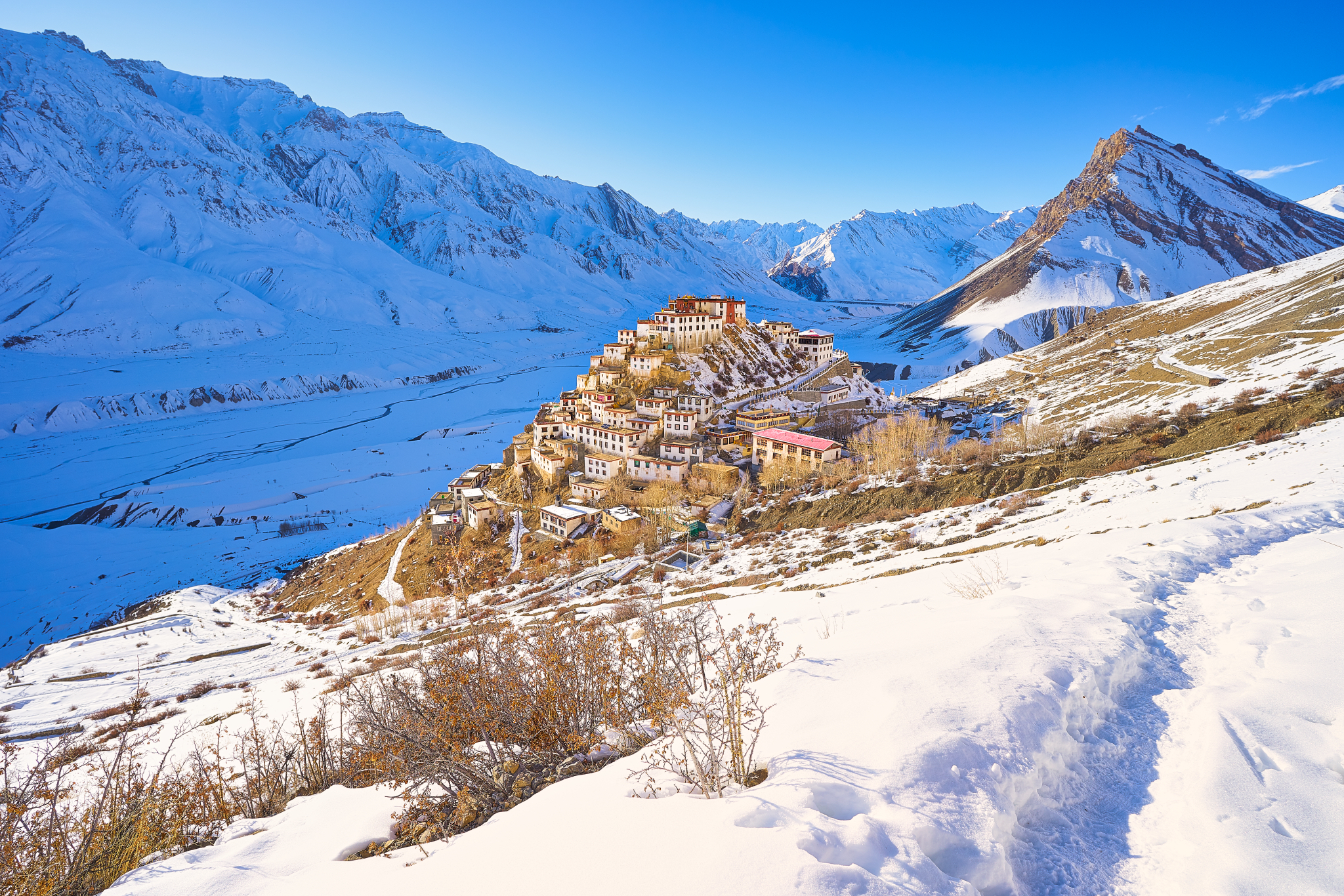
I have found that the greatest degree of inner tranquility comes from the development of love and compassion. The more we care for the happiness of others, the greater is our own sense of well-being. Cultivating a close, warmhearted feeling for others automatically puts the mind at ease. It is the ultimate source of success in life.
— Dalai Lama XIV

A few months back, a friend of mine suggested that I read The Heart of Meditation by Dalai Lama. Like every great book that I’ve read, this too had helped me fundamentally alter the way I think, feel, and do. The heart of this book talks about the Buddhist spiritual path, which is the practice of empathy, meditation, and knowledge. The practice helps in developing a deep sense of love and compassion that leads to the greatest degree of inner tranquility and eventually brings about the utmost clarity in our minds. Being a meditation practitioner myself, I was instantly able to relate to what the Dalai Lama was saying. I’m grateful to have known the practice of meditation and have observed radical changes in my behavior, thinking, and above all the way I feel. I find it a lot easier to move away from all forms of negativity to a state that is defined by love and compassion.
The book has not only inspired me to live my life in a certain way but has also made me deeply curious about the Dalai Lama. I’ve been reading quite a bit about him in the last few months and have been greatly inspired by his life, teachings, and travels. He has been a monk almost all his life, traveled to 67 countries spanning 6 continents, and authored or co-authored more than 110 books. He has received over 150 awards including the Nobel Peace Prize in 1989, in recognition of his message of peace, non-violence, inter-religious understanding, universal responsibility, and compassion.
Despite all his achievements and fame he still prefers calling himself a simple Buddhist monk. In the heart of his ordinary disposition is his extraordinariness. In the heart of his meditation practice is his compassion. To have lost his own country and still being able to spread the message of love and compassion is exemplary to say the least. When world leaders and all humans at large start thinking like him, there will be no war, no unrest, no violence … we will end up living in eternal peace.
While reading about his life, I was quite intrigued to learn that he wants to retire in a village called Tabo in Spiti. Up until that point, Spiti to me was a land of incredible landscapes. Neither was I aware of Dalai Lama’s deep spiritual connection to Spiti nor was I aware of Tabo Monastery—the oldest continuously operating Buddhist enclave in India and the Himalayas. It was awe-inspiring for me to learn about Tabo Monastery’s historical role as an intermediary between India and Tibet. From what I could gather, it played a pivotal role in the history of Buddhism in the tenth and eleventh centuries, when Tibetan monks and Indian pandits studied together and translated scriptures from Sanskrit into Tibetan. Then I knew, I had to visit Spiti and especially Tabo.
Fri, Dec 20 2019
It was 8 am, and the cab to the airport was at my doorstep. Everything went according to plan quite unlike my last trip to the mountains. The cab was on time, it reached the airport on time, the flight was on time, and I landed in Chandigarh on time. I’ve never been to Chandigarh before but I’ve heard it’s a good place to live in. However, strangely enough I wasn’t too keen to go around the city. All I wanted to do was to check into the hotel, eat something, and sleep. And that’s exactly what I did.
Sat, Dec 21 2019
I woke up around 5 am and for a few moments had no idea what I would do next. The scheduled time for our journey to Spiti was a good six hours away. Normally, at that hour, I would meditate but somehow my mind was racing and I was unable to quieten it down. I was thinking of the Dalai Lama, Spiti, temperatures touching -30ºC, going without bath for a whole week, and all sorts of random things. They were just a stream of thoughts though … I didn’t feel anxious. My sixth sense said that I’ve found an incredible travel partner in Incredible Spiti and there was nothing to worry.
Finally, the time came when I had to head back to the airport where our pickup was scheduled. I gathered myself, my thoughts, and my belongings and headed back to the airport. There I met Tenzin (our guide) and Dev (our driver)—both of whom, I would later realize, were the best in what they did.
The sun was about to hide behind the mountains when we reached Shimla. I was visiting Shimla after three decades and I could barely recognize it. The sheer number of houses, people, cars, and shops overwhelmed me. I felt a bit sad.
Our stay for the night was at Rampur, about 80 miles from Shimla. Though there was a certain chill in the air, it wasn’t something that bothered me much. I took a warm bath, which would be the last one for the next 5 days, had dinner, and went to bed a bit earlier than usual. We would be starting early tomorrow, much before the sun comes up.
Sun, Dec 22 2019
We started from Rampur when the dawn was still dark. On our way to Spiti, I was expecting to see some colors, at sunrise, on the snowy peaks. We stopped for a while at a village called Badhal, for those who wanted to have breakfast. As I was getting down from the car, the first rays of the sun was starting to lit up Kinner Kailash. I was awestruck by the beauty that was unfolding right before my very own eyes and I almost forgot about taking a photo. However, before it was too late, I managed to grab my camera and capture the other-worldly golden crown of Kinner Kailash.
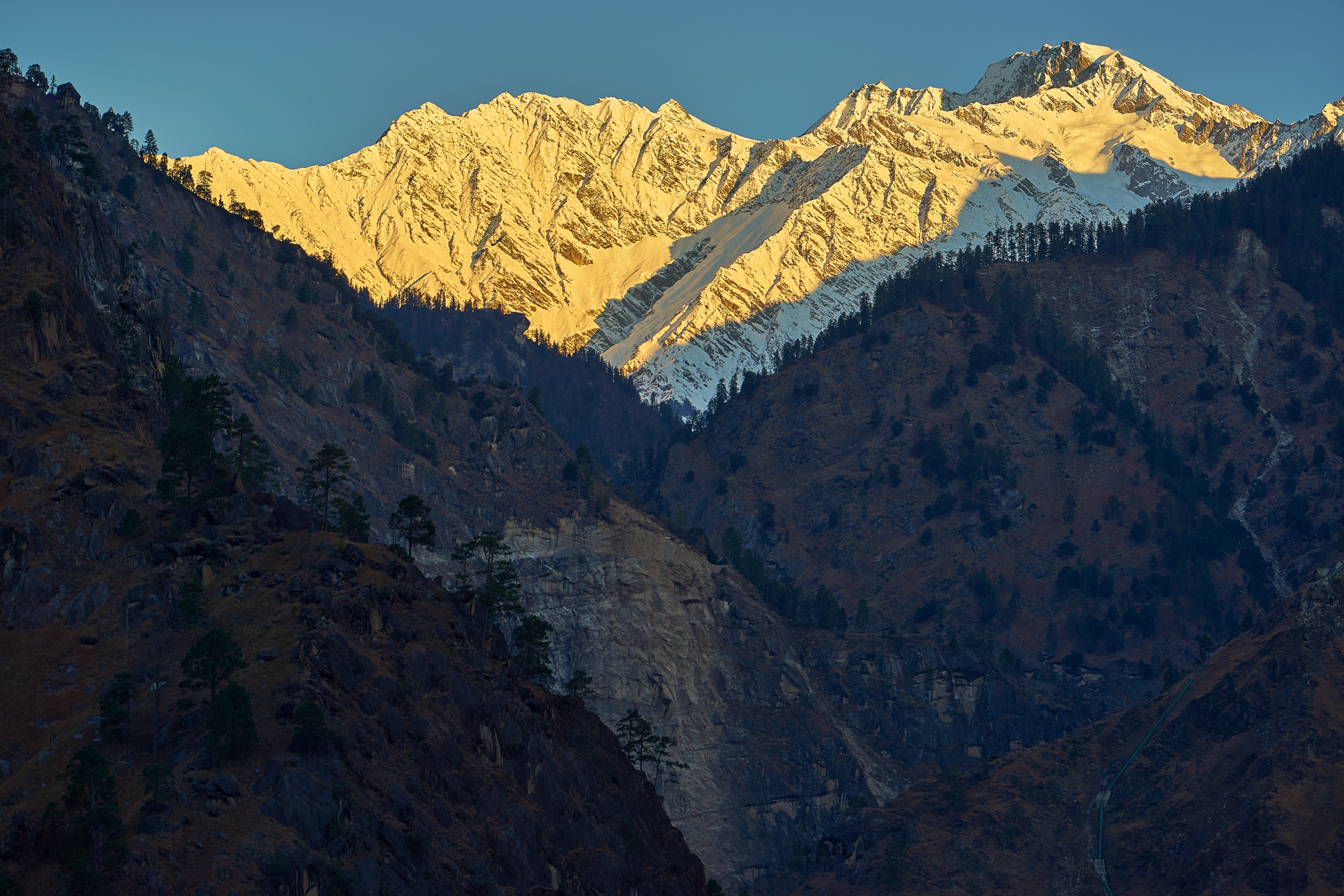
As we continued to drive on NH 5, the views kept getting better. Breathtaking views at Kalpa, Spello, Pooh left me gasping. At a distance, I could see the bridge that connects lower Kinnaur with upper Kinnaur and a jaw-dropping view of the mountains forming a stunning backdrop.

The upper areas of Kinnaur fall mainly in the rain-shadow area. These areas are considered to be arid regions, similar to the climate of Tibet. That would be our first glimpse of the middle land—the land between India and Tibet. However, just before we entered upper Kinnaur, Dev stopped our car at the other end of the bridge at Khab Sangam—the confluence of Sutlej and Spiti rivers. We spent some time there, appreciating the beauty all around. Since it was almost midday, the light was quite harsh and wasn’t really ideal for taking photos. Nevertheless, I did manage to take a couple of shots that turned out to be fairly decent.
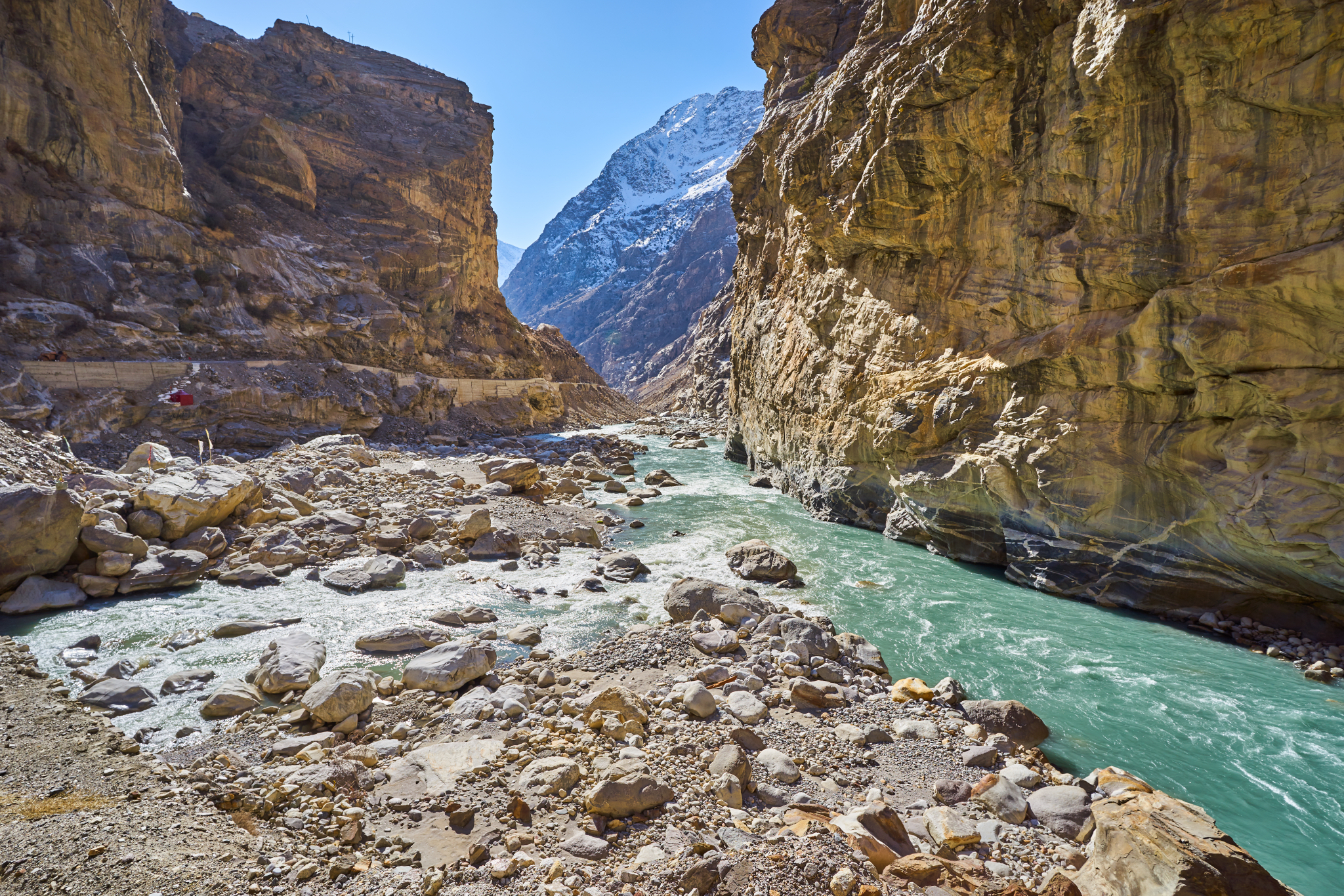
The converging cliffs on either side formed an archway as NH 5 now gave way to NH 505. As we drove along the Spiti river the tall cliffs on our left opened up to expose the Hangrang valley.
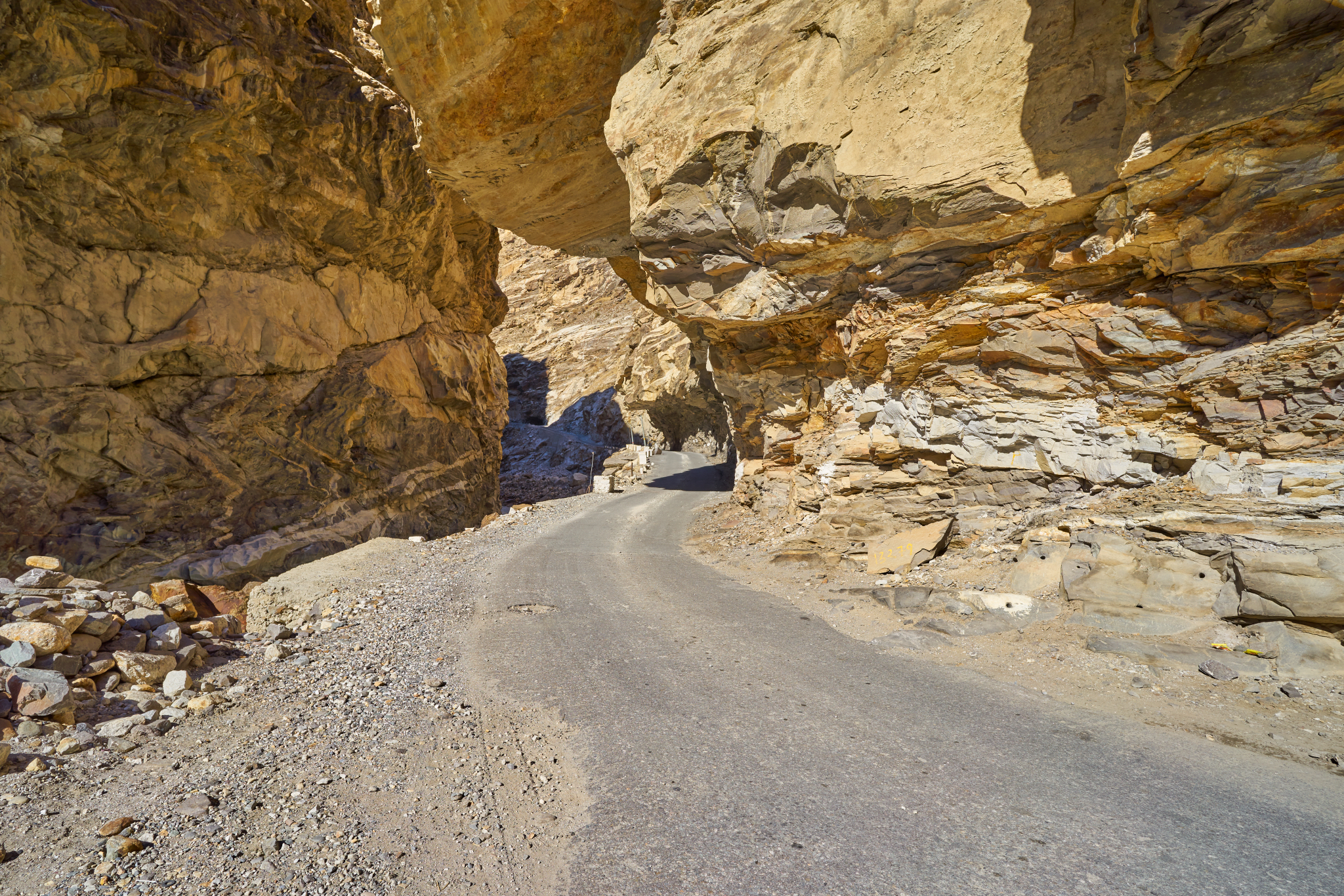
Hangrang valley is a wide expanse of barren landscape with lofty mountains and snow-capped peaks. The slopes are studded with little villages that gave us a glimpse of what the Spitian villages may look like.
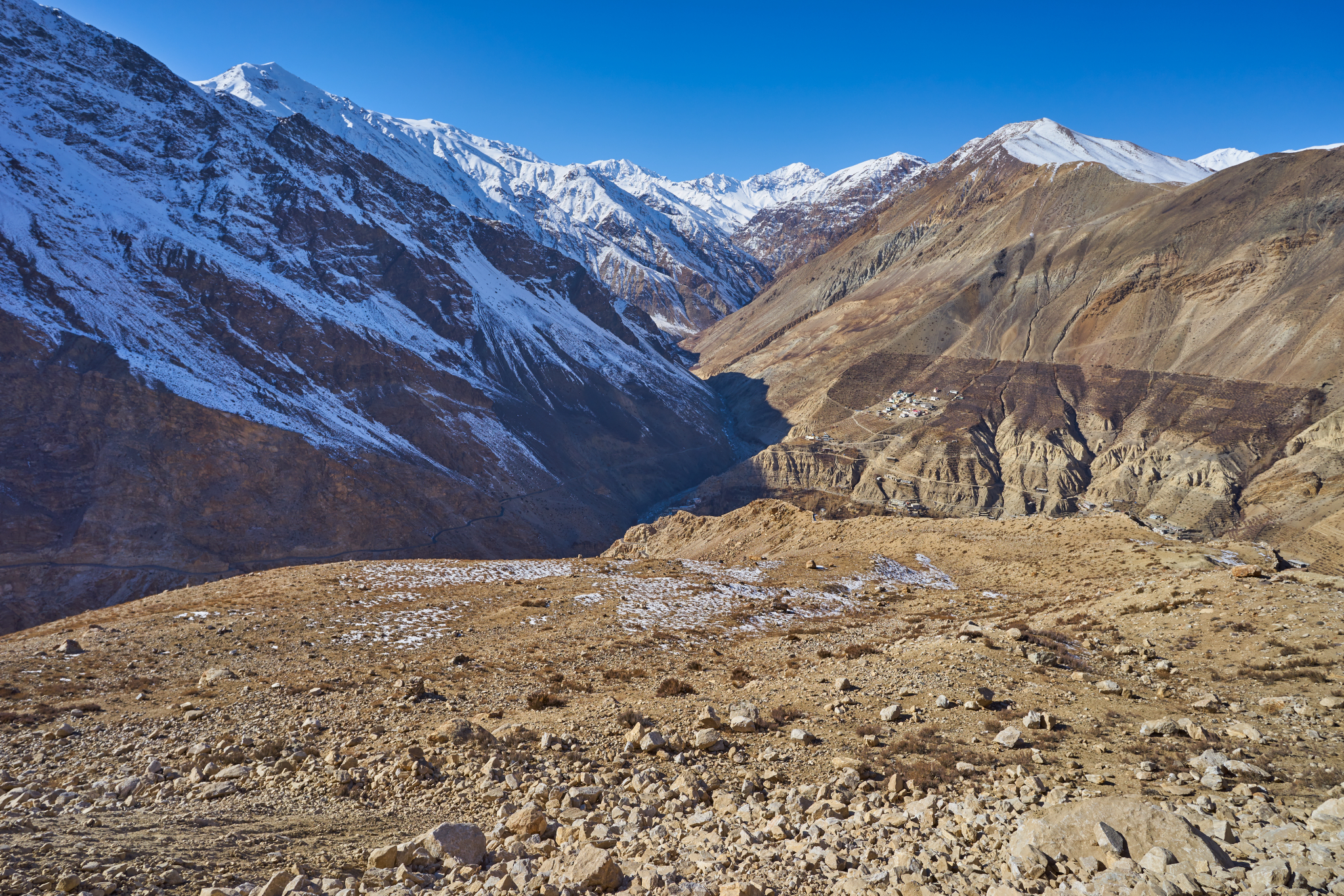
After an exhilarating drive through Hangrang valley we reached Nako—a small village near the Nako Lake. The village, that was originally situated on the other side of the Nako river, was destroyed by an earthquake in 1975. It was then rebuilt at its present site. This is also where we had our lunch. I was intensely hungry by that time and literally gorged on a bowl of Thukpa.
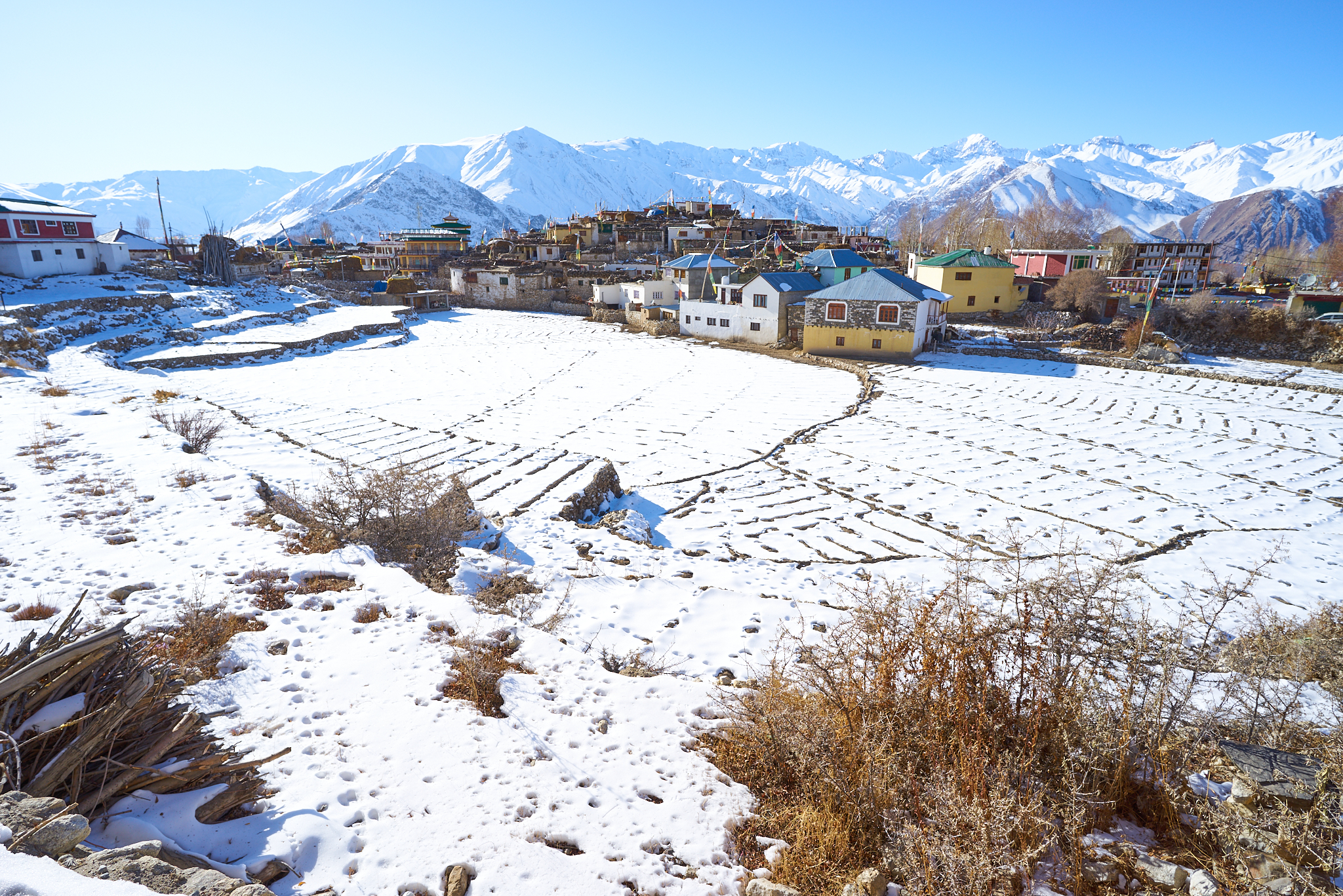
After our lunch, we hiked up to Nako Lake. It was completely snow covered apart from a spot where you could see through the ice. I kneeled down and took a photo from that spot. Toral, a fellow traveler, took my photo. I mention it because it’s a rare occurrence as I generally find myself on the other end of the camera. 🙂
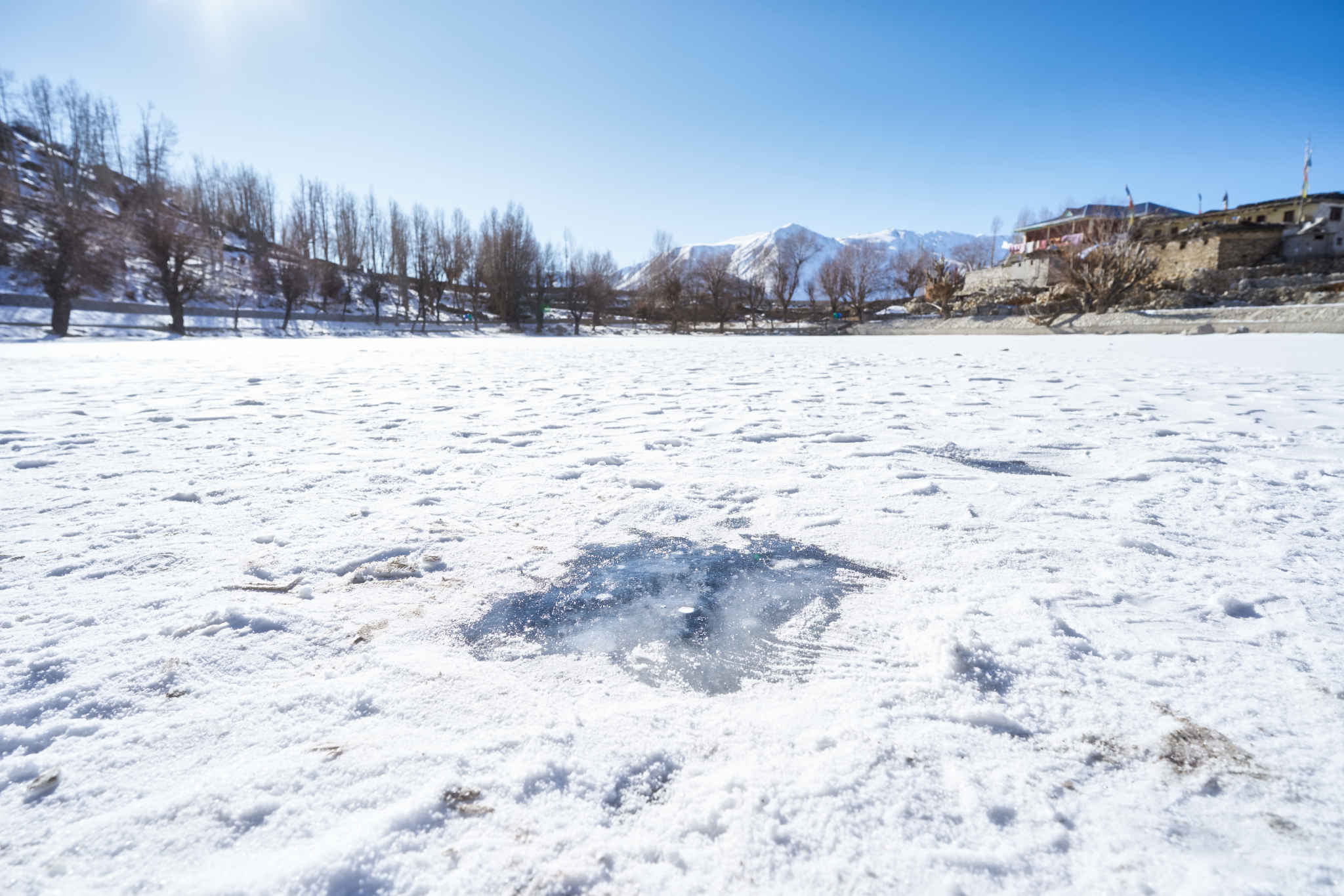
Soon after we headed for Tabo—the land where Dalai Lama wants to retire. And I was about to find out why.
It was getting dark when we reached Tabo. The sun had already hid behind the mountains. Gusts of cold wind gave me a shiver down the spine. We were welcomed by Tenzin—not our guide but our host for the night. His home was warm, simple, elegant and cosy. In the fading light, all I was able to figure out was that we were surrounded by big mountains. I was looking forward to see how the sky looked at night.
Tenzin was quite welcoming and made us feel comfortable almost immediately with his smile and cheerful conversations. We all sat in the living room around the ‘tandoor’—a local heater that doubles up as a gas stove. Tenzin—our guide—got me a book about India and Tibet. I read a few chapters in between our conversations. I learnt quite a bit about the cultural bond between India and Tibet, the monasteries, and the significance of the middle land.
At about 10 pm, I looked out of the window toward the western sky. There were a billion stars and the Milky Way—our very own galaxy—was as clearly visible as it could be on a December night. Though it doesn’t look as attractive as it does in the summers, the wide expanse of the sky studded with stars always fills me with awe. I feel grateful and insignificant at the same time. It’s a feeling that’s hard to express. On one hand we are made of starstuff—the nitrogen in our DNA, the iron in our blood, the calcium in our bones have all been formed out of stars collapsing into each other. Our connection to them is irrefutable, and yet we are just a speck of dust in a speck of galactic dust. Every time I look up at the sky I’m almost on the verge of joyful tears. I feel grateful to have the consciousness to experience the beauty and the vastness of our ever expanding universe. I look up at the sky just because I can.
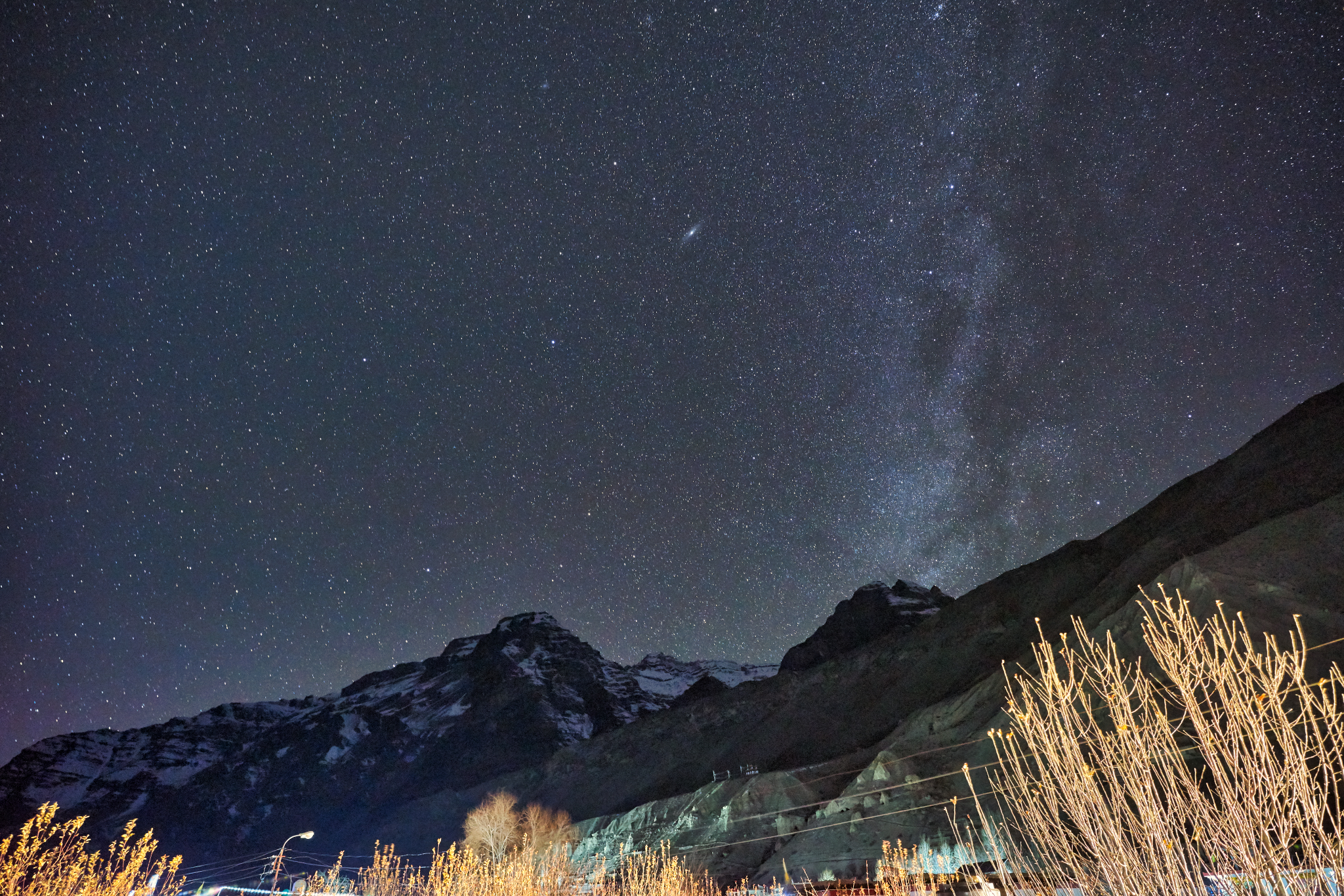
However, taking a shot of the night sky was a bit more challenging than usual. I had to take off my gloves to change a few settings. Temperatures were hovering around -25ºC and in a few seconds, my fingers seemed frozen as I had a hard time pressing the shutter. The camera worked like a charm but I was struggling—it was an ordeal just to press the shutter. But at the end, the photos are worth its weight in gold and then some. I look at them whenever I feel like reliving my connection with the universe. I look at them just because I can.
Mon, Dec 23 2019
The next morning, as I looked out of the same window, I saw a very different scene. The sun had lighted up the mountains on the western side and they were looking like a pile of gold. I immediately switched over to a telephoto lens and it almost instantly transferred me to a different world. The stark contrast of light and shade and the lens compression of the telephoto helped me capture the jaw-dropping photo below.
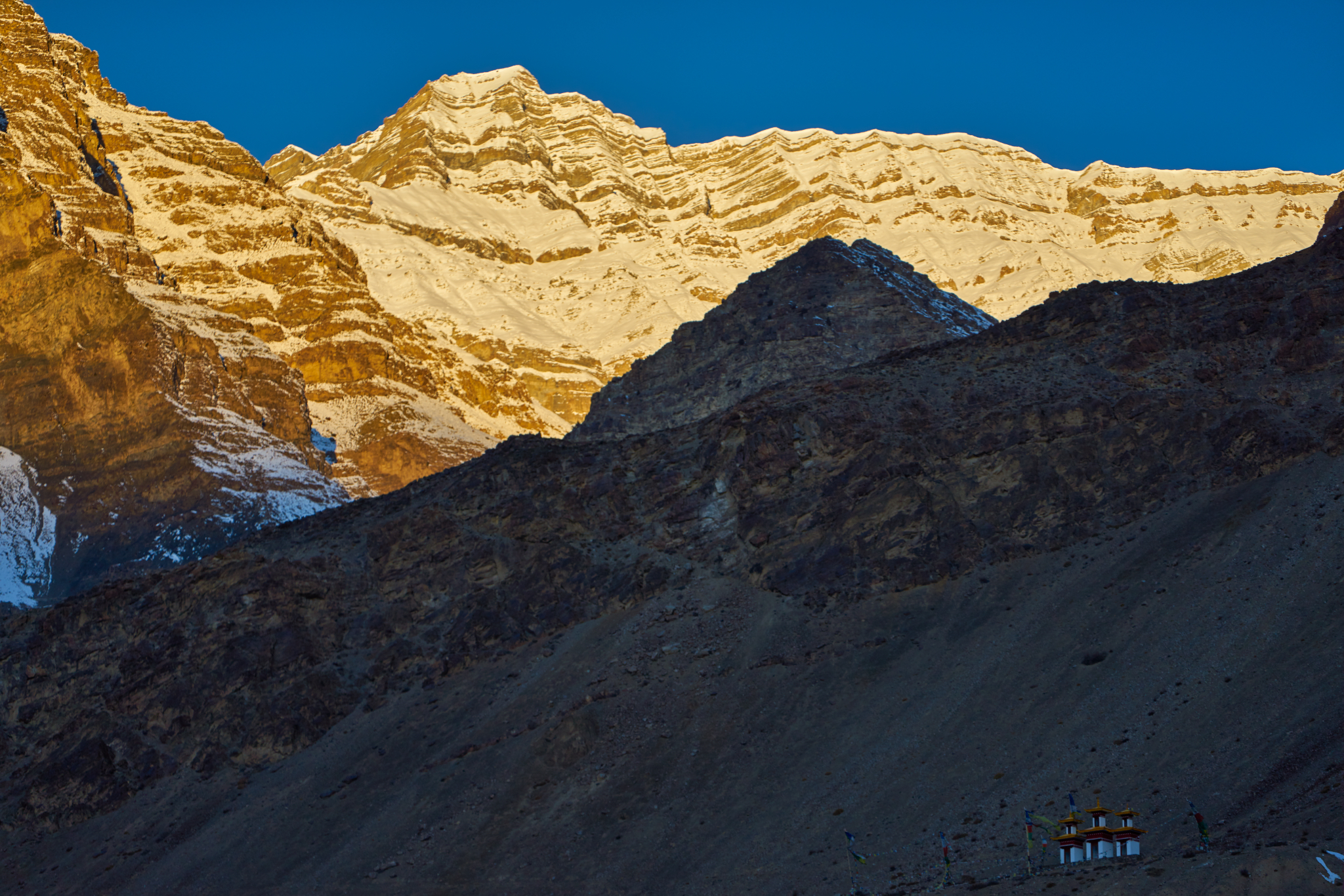
Finally the moment arrived; the moment to visit the Tabo Monastery. Founded in 996 CE it is the oldest continuously operating Buddhist enclave in both India and the Himalayas. It was a short walk to the monastery. We entered through an ornate thousand year old wooden door. The monastery and its surrounding mud brick wall almost seamlessly blends with the surrounding mountains.
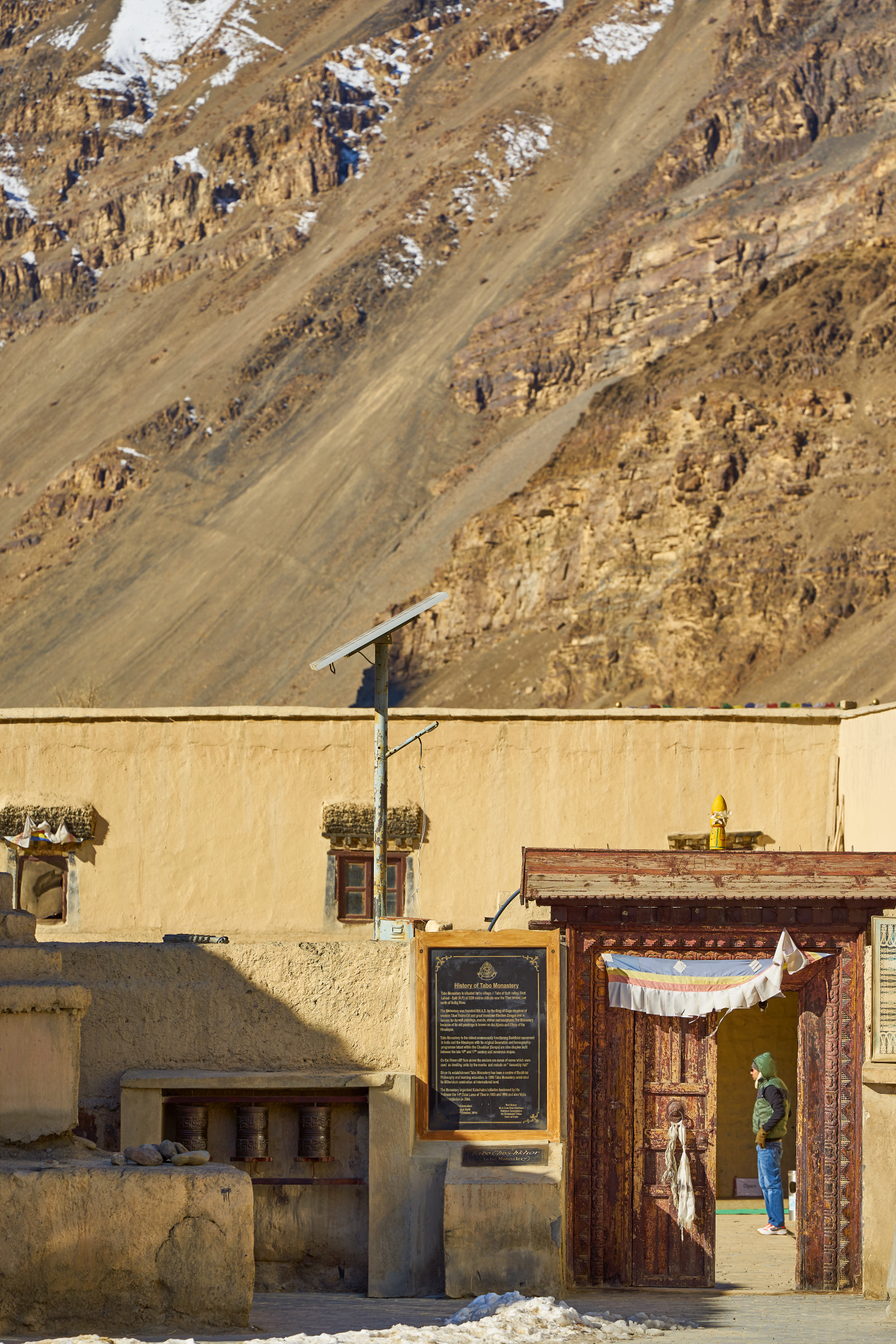
The inside of the monastery was warm and dark. It was lit by a small sky window. There is a certain calmness that almost immediately draws you to a meditative state. I could somewhat sense why it’s Dalai Lama’s favorite place to retire.
There are many priceless collections of thankas (scroll paintings), manuscripts, statues, frescos, and murals that cover almost every wall. The original monastery was severely damaged in the 1975 Kinnaur earthquake. Thereafter, it was fully restored and some new structures were added. In 1983, after the Kalachakra Temple was built, the Dalai Lama visited the monastery and initiated the Kalachakra Festival (a process of initiation and rejuvenation).
I was quite impressed by the Bodhisattva Maitreya Temple—an ancient temple built in the first 100 years of the main monastery. The statue of the Bodhisattva Maitreya (future Buddha) here is over six metres (20 feet) high.
After, our visit to the monastery we decided to climb up a cliff face to get a bird’s-eye view of the monastery. There are a number of caves carved into the cliff face that are used by the monks for meditation. I sat in one such cave and saw this unique view of the monastery. The old (made of mud walls) and the new monasteries can be easily distinguished.

The surrounding views from the cliff face were equally stunning. There was a certain element of synchronicity of me standing on a cliff face and observing the small villages, the snowy peaks, and the mud mountains that made up the valley. It was almost transcendental!
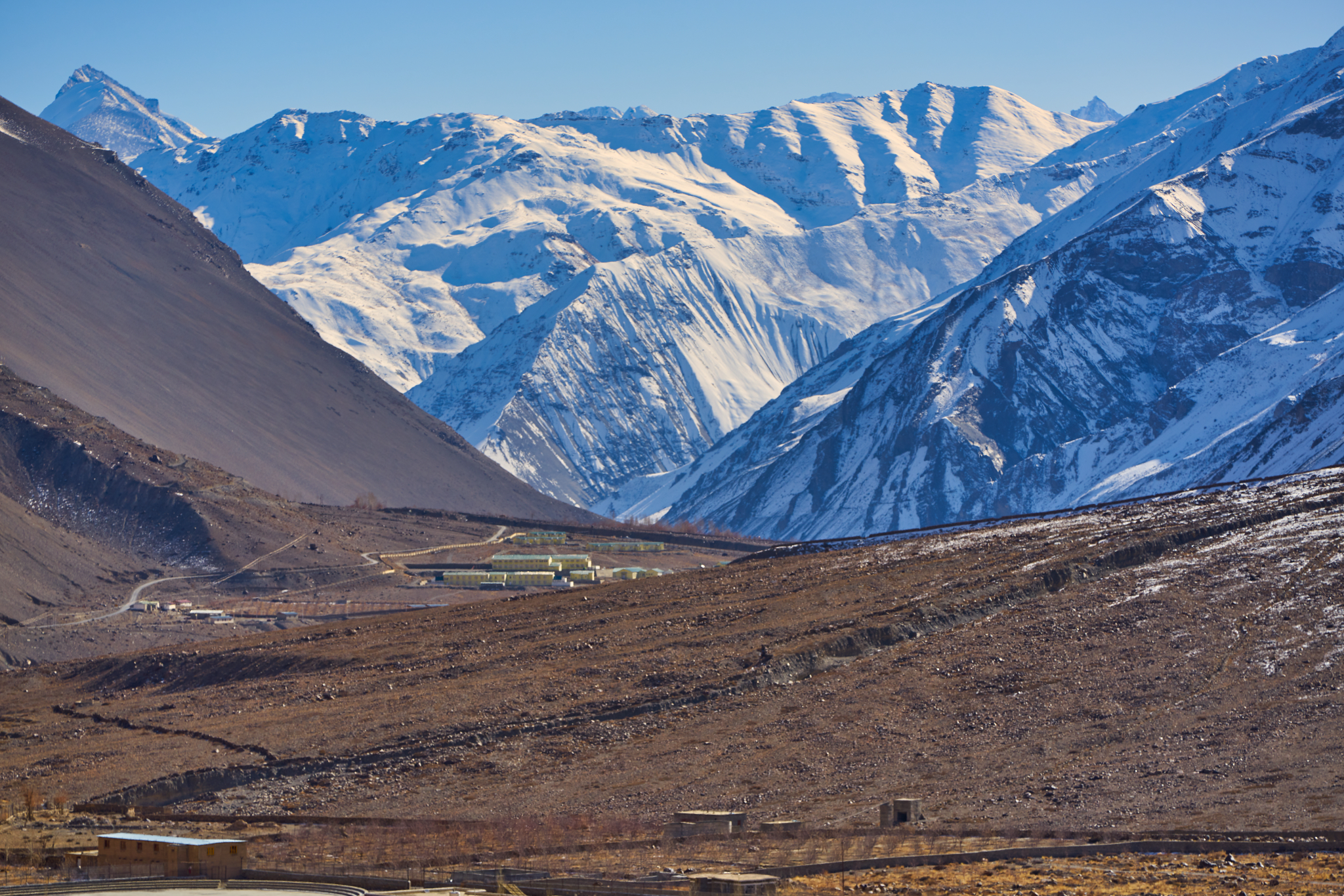

Our next destination was Dhankar. On our way, we saw some stunning views of mountains covered in a blanket of snow, which were studded with little villages that added some color to the pristine landscape. I also noticed some eluvium structures emerge out of the cliff faces on our way to Dhankar. It’s a landscape best described by photos.
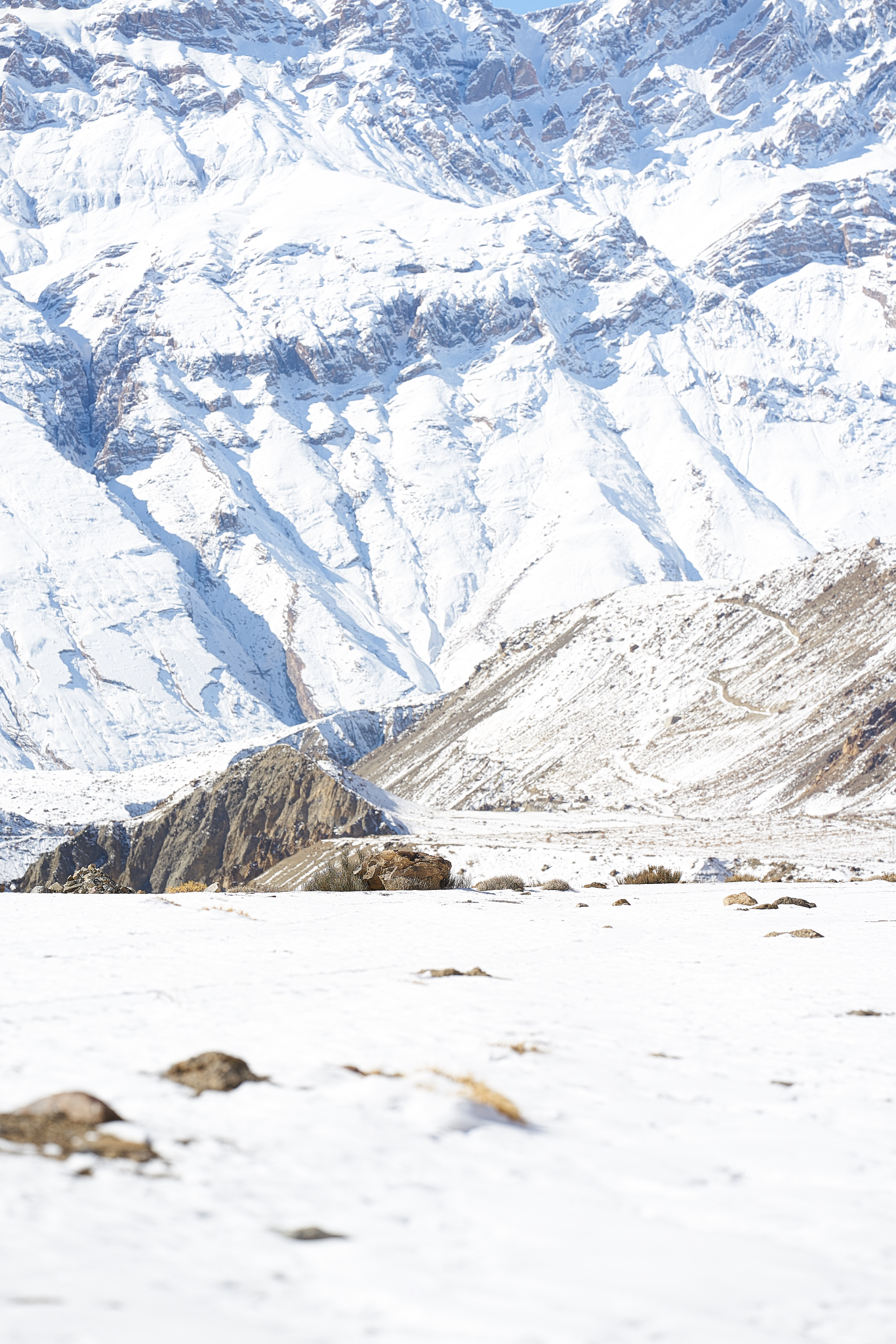
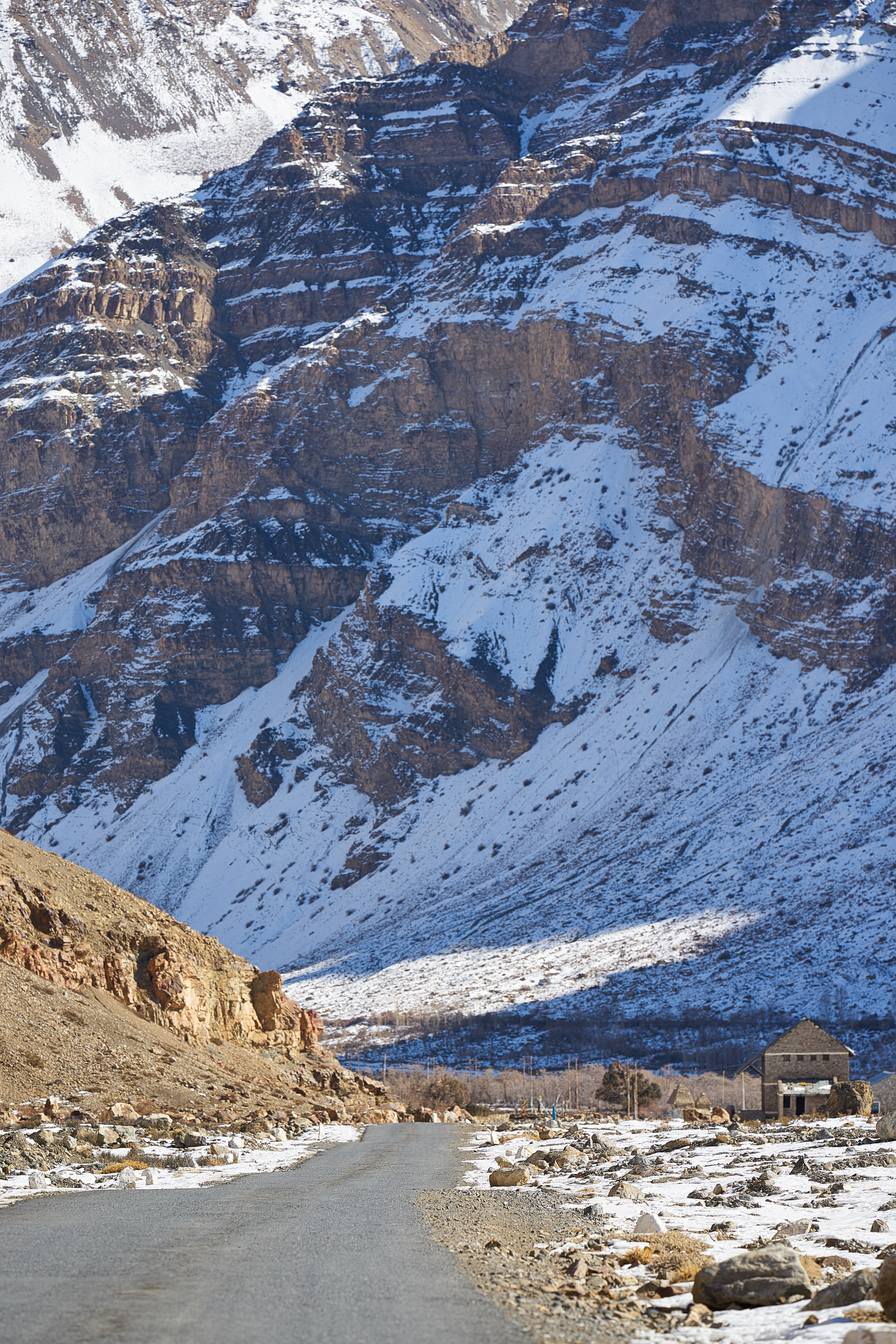
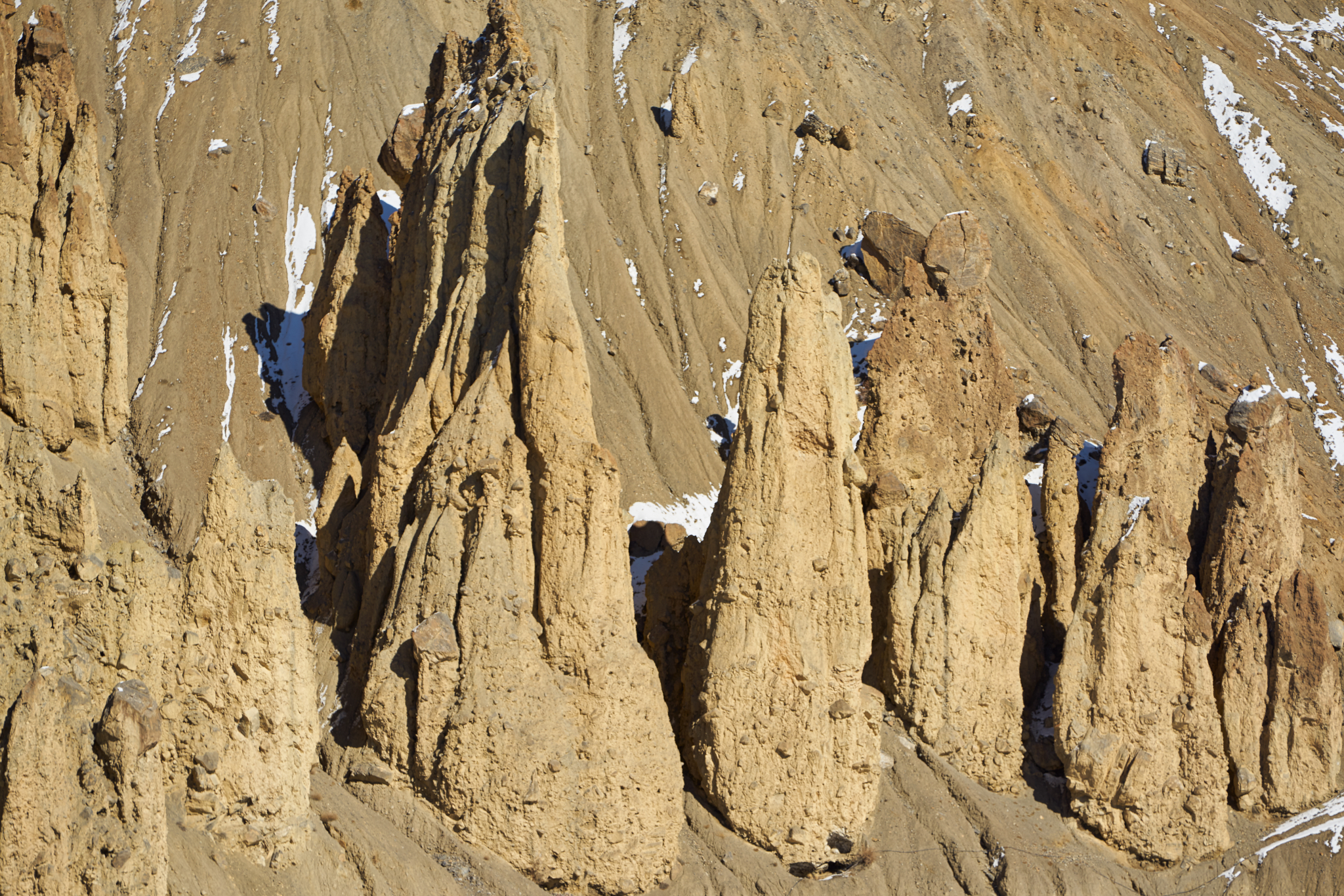
Dhankar Gompa, situated at an elevation of 12,774 feet, is one of the world’s most spectacular settings for a gompa (monastery). Dhang or dang means cliff, and kar or khar means fort. Hence, Dhangkar means fort on a cliff. It was built as a fort monastery on the Central Tibetan pattern. The fort is the one above (top center of the photo), and the gompa is the one below to the left. The Shichilling village can be seen on the lower right of the photo.

Shichilling village contains the new Dhankar Monastery, home to about 150 monks belonging to the Gelug school of Tibetan Buddhism.
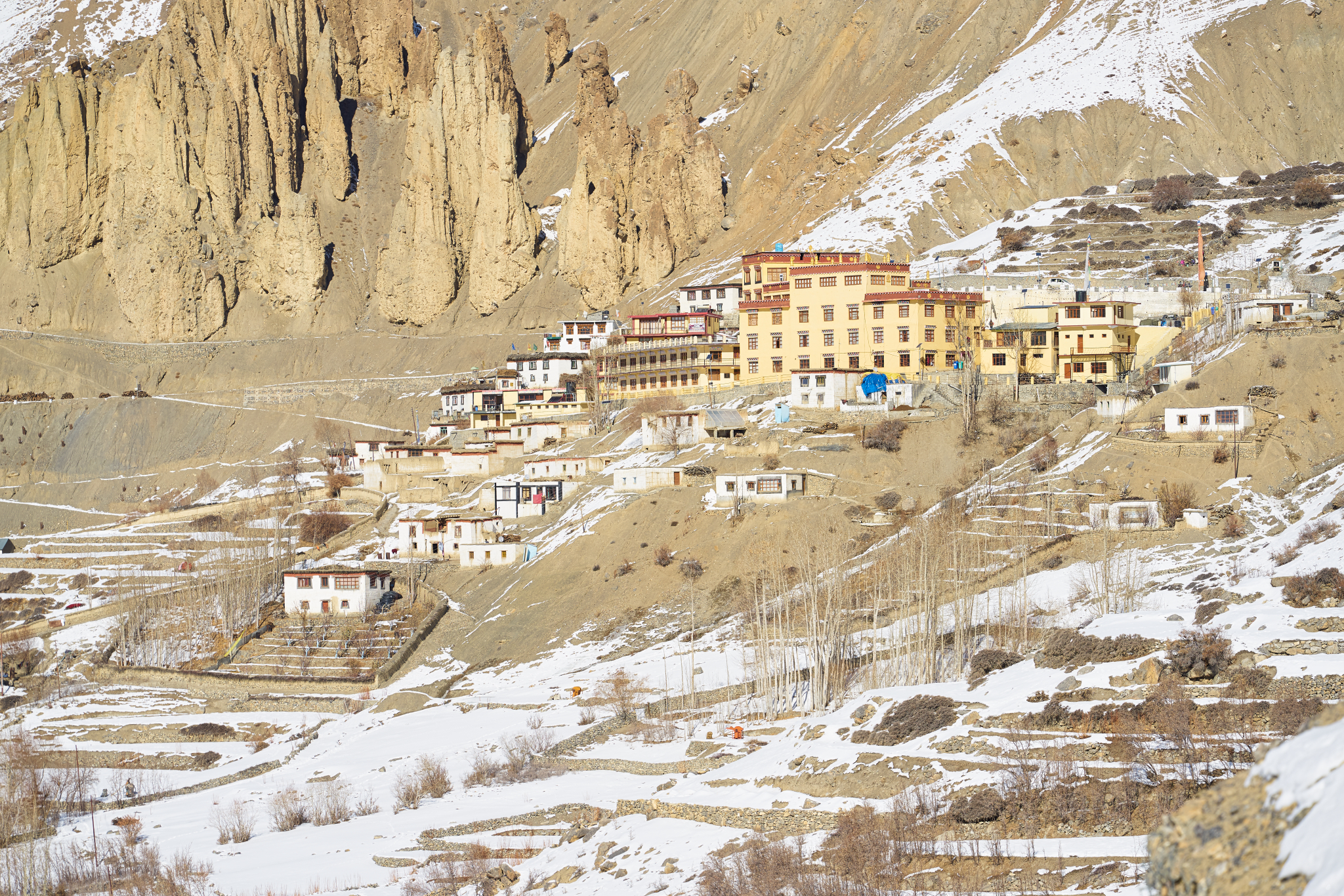
As I started hiking around Dhankar, I was mesmerized by the stunning views that it offered. It was an eclectic mix of snow-capped peaks and eluvium structures.
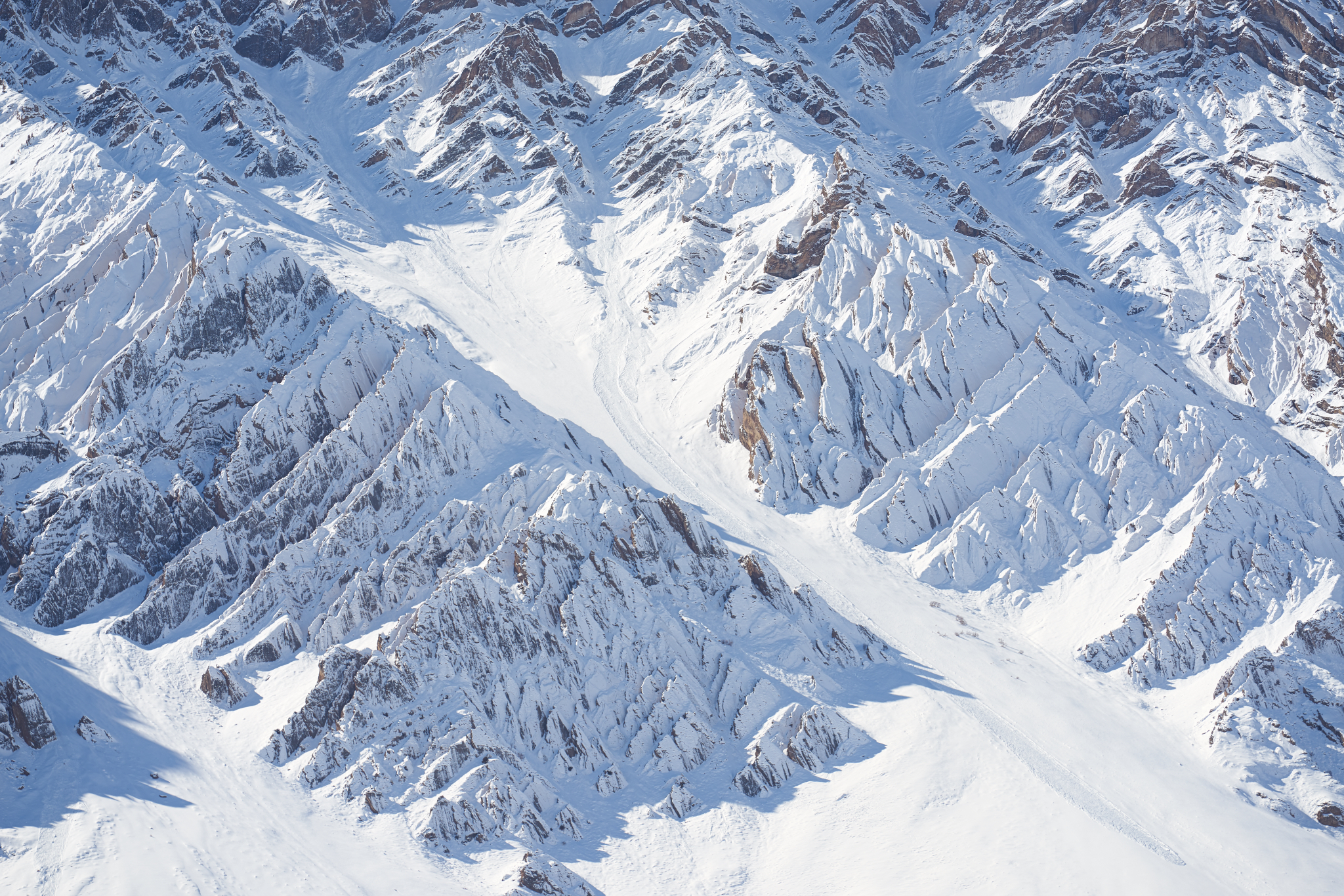
As I stood on a ledge, the confluence of Spiti and Pin rivers literally took my breath away. Pin valley was our next destination and I practically couldn’t wait to get there. It was a bit early in the season for a chance to spot a snow leopard or two but a man can always wish. 🙂
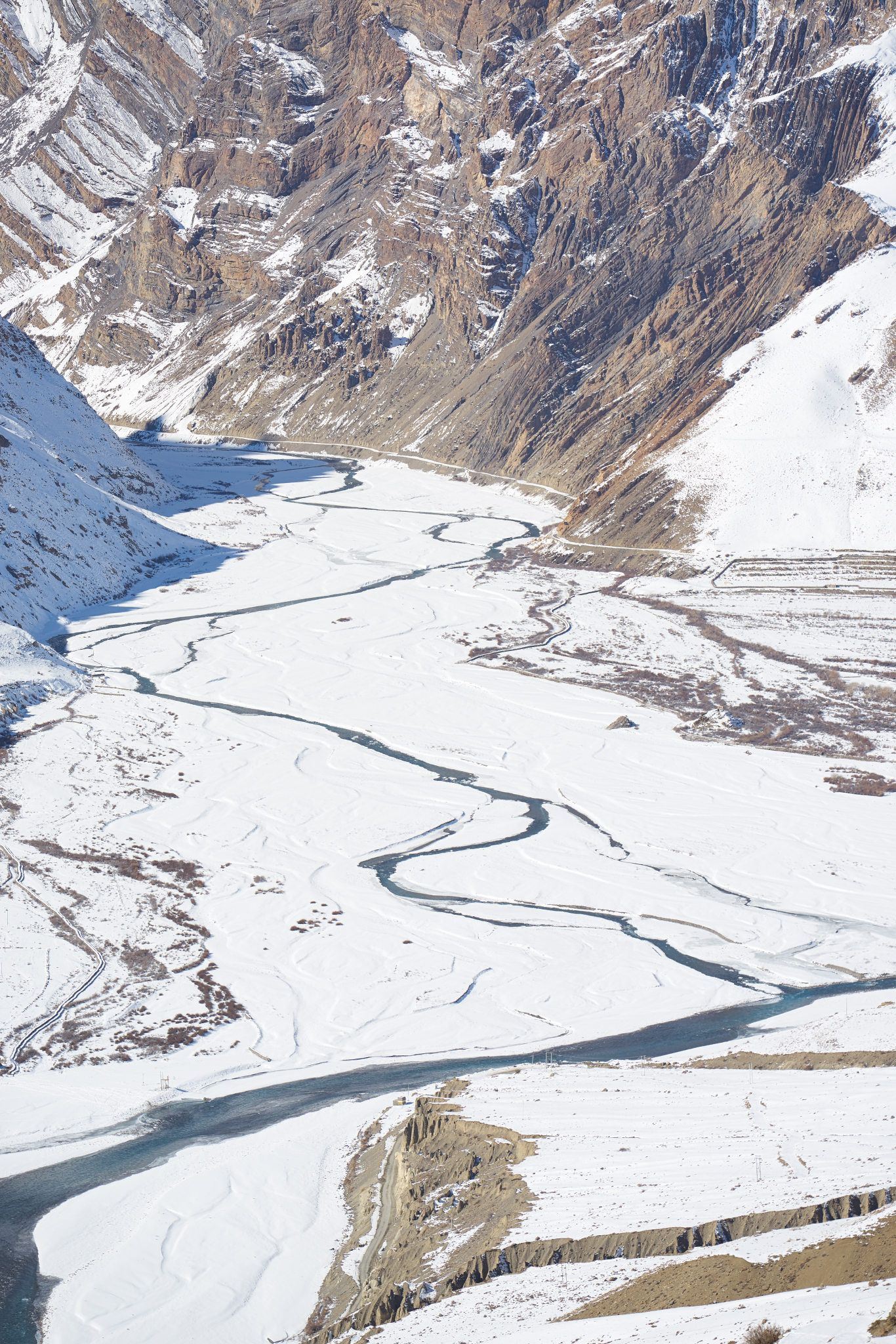
The door of the Dhankar Gompa was closed. Strangely, I wasn’t disappointed to see the closed door. Rather, I felt empathic toward the plight of the monks and villagers who has to make ends meet just to survive in this harsh weather. I wouldn’t be too surprised if the monk had gone to arrange for his lunch.
Soon after, we left for Pin Valley National Park. The park spreads south of Dhankar Gompa near the Tibetan border, and marks the border between the formerly separate districts of Lahaul and Spiti. On our way we saw a frozen waterfall at Lingti valley. I’m told that the ice climbers often climb this beauty. We stopped there for a while and took some photos.
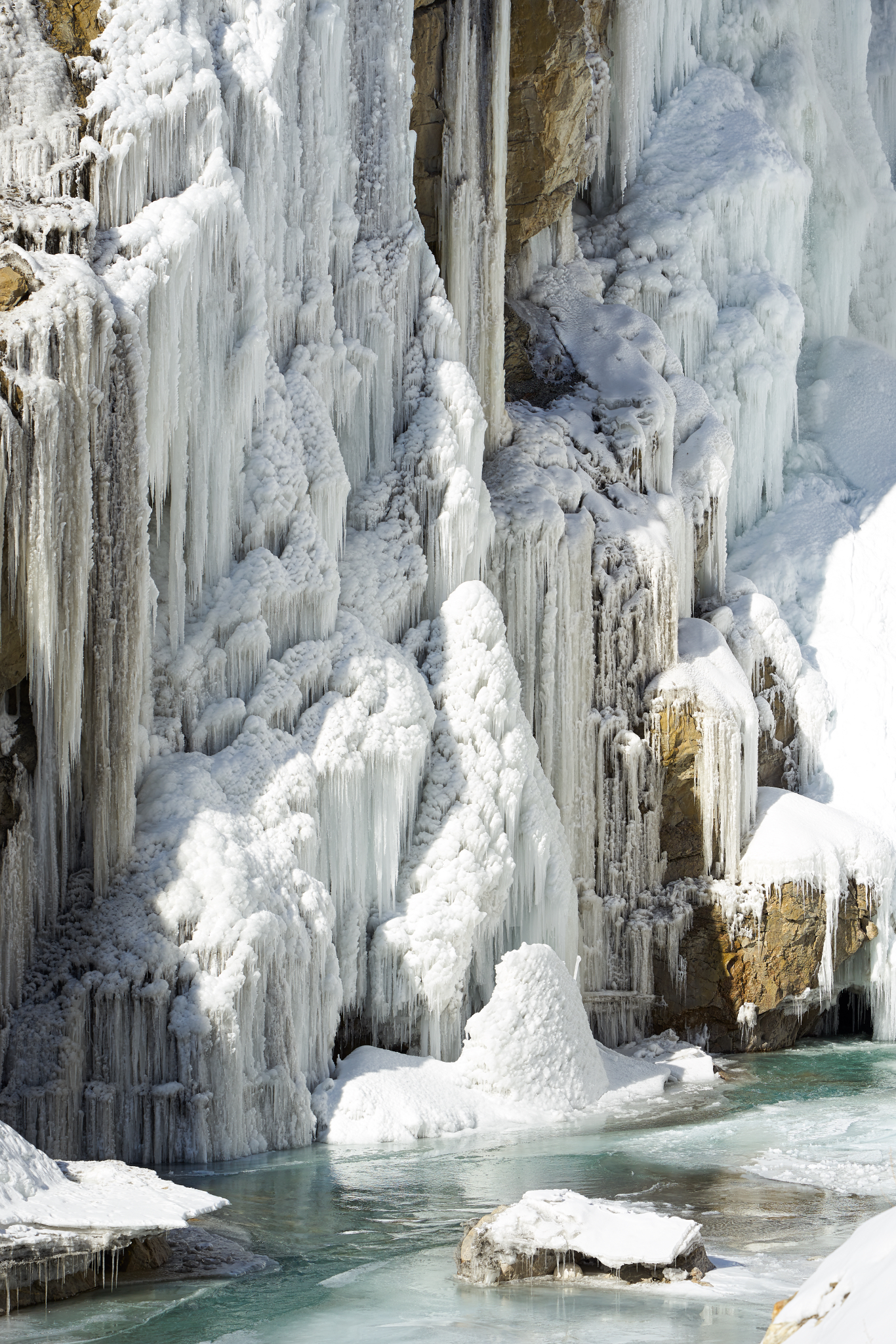
While taking photos I observed an Alto car approaching us. It’s generally quite strange to find Altos as opposed to 4x4s in a mountainous terrain like Spiti. But thanks to Tenzin, we knew by now that if it’s an Alto then the owner must be a local. They drive these small petrol vehicles so that they don’t face problems due to freezing (regular diesel freezes in sub zero temperature) and can be pushed or towed easily in the rare cases that it fails to start or breaks down.
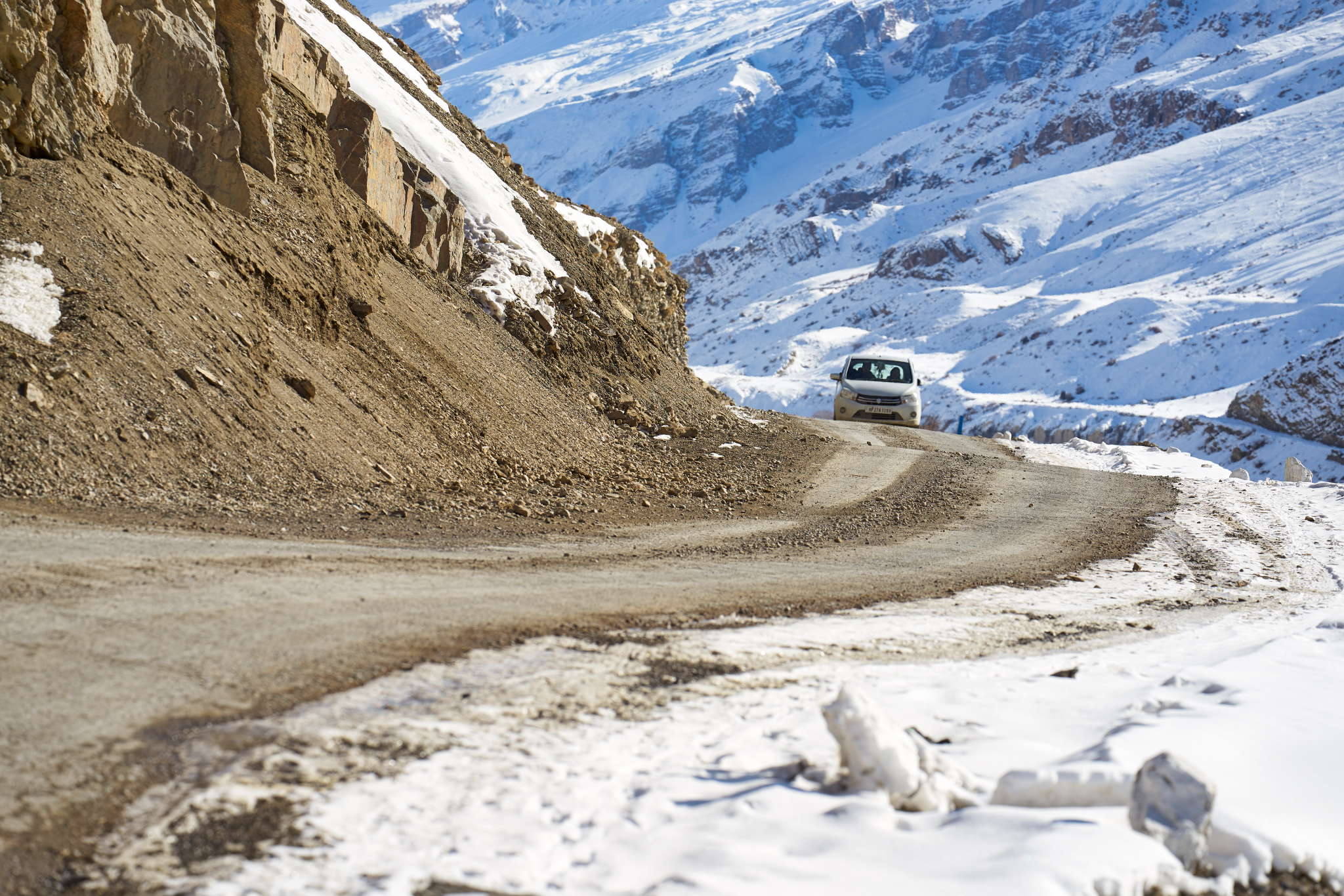
In about 90 minutes we reached Pin Valley National Park. The entire valley was covered in a blanket of snow interspersed with differently colored rocks.
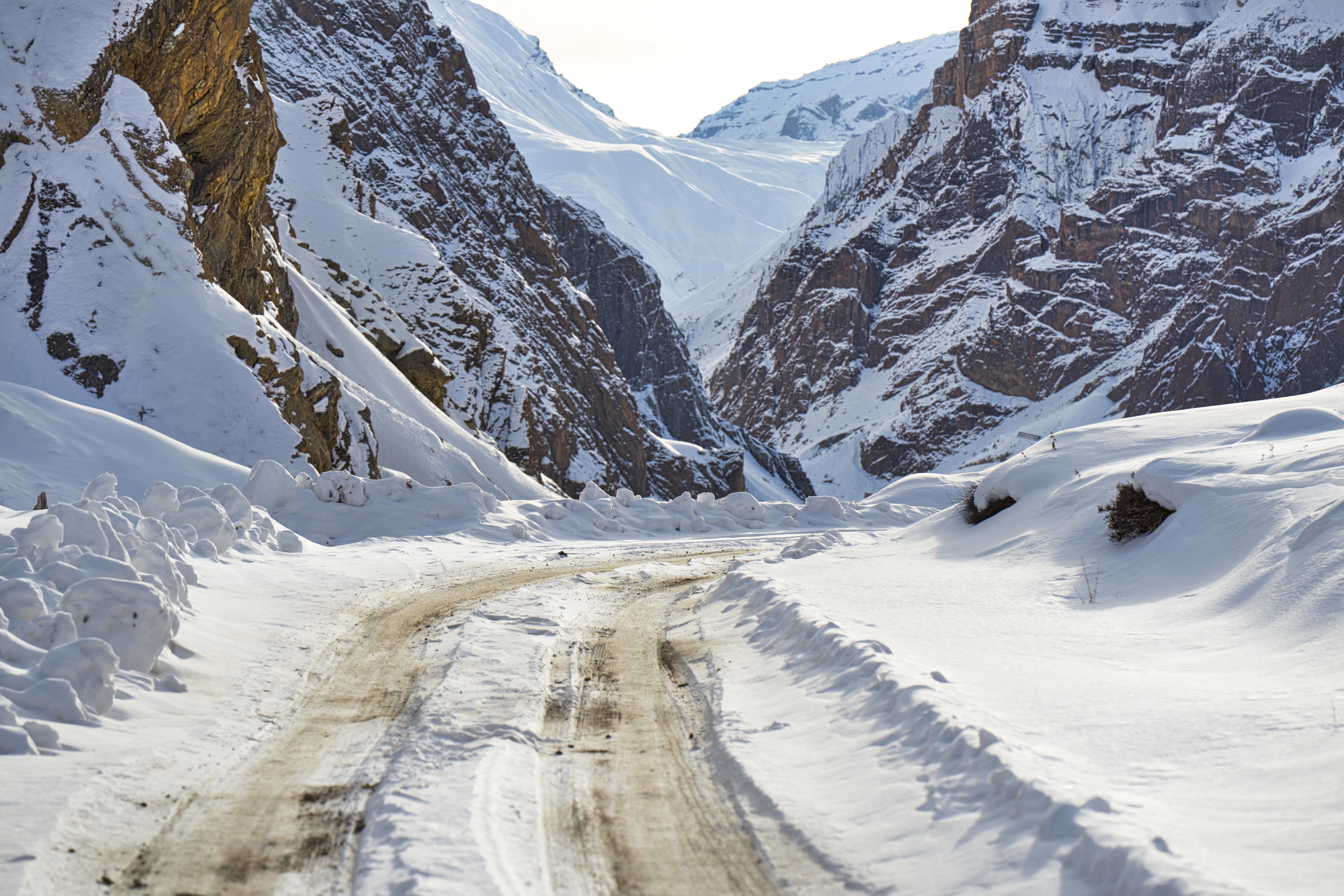
The steep red cliffs reminded me of the red rocks in Arizona. I recalled the few moments of hallucination that I had experienced when I had witnessed the Wave for the first time. 🙂
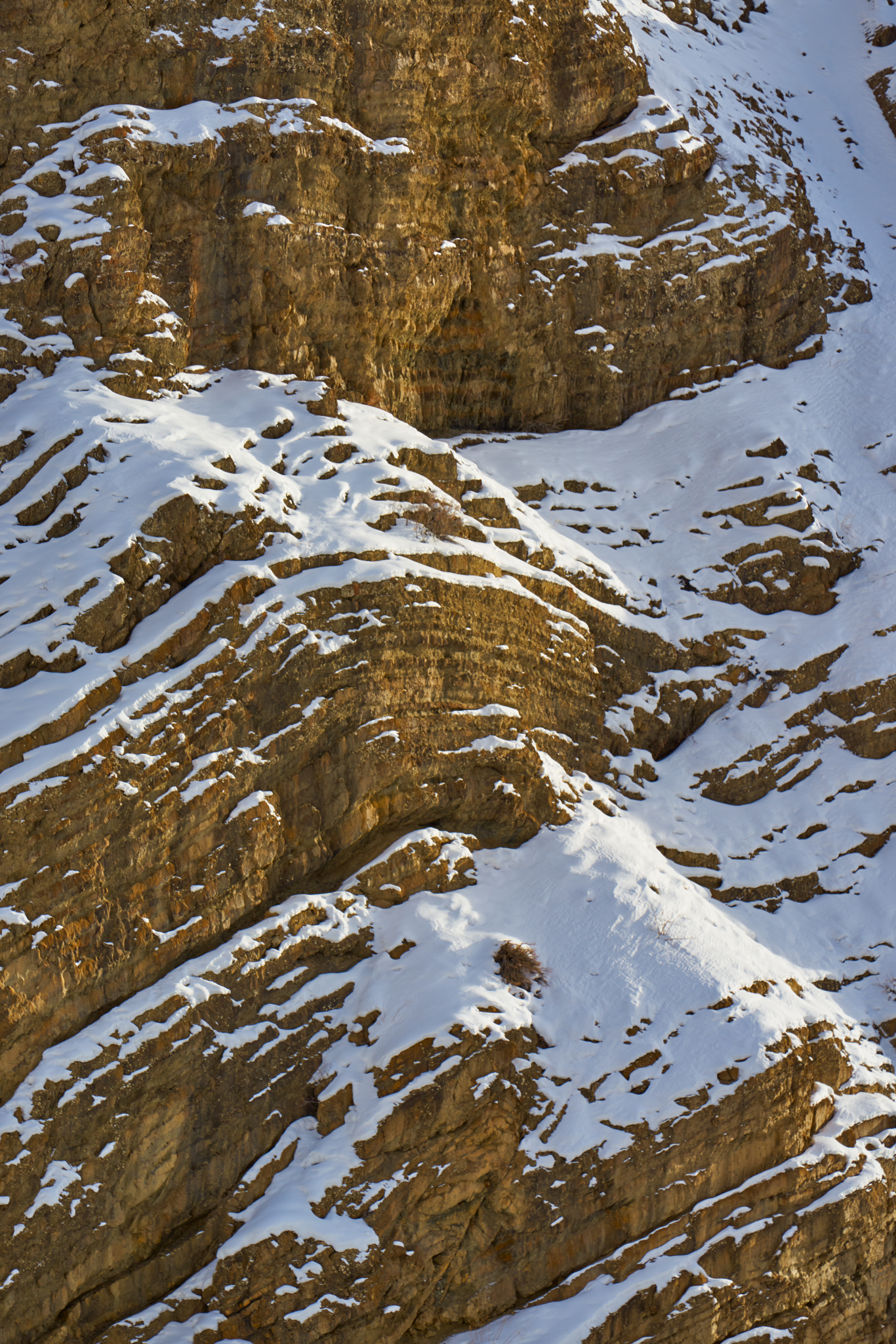
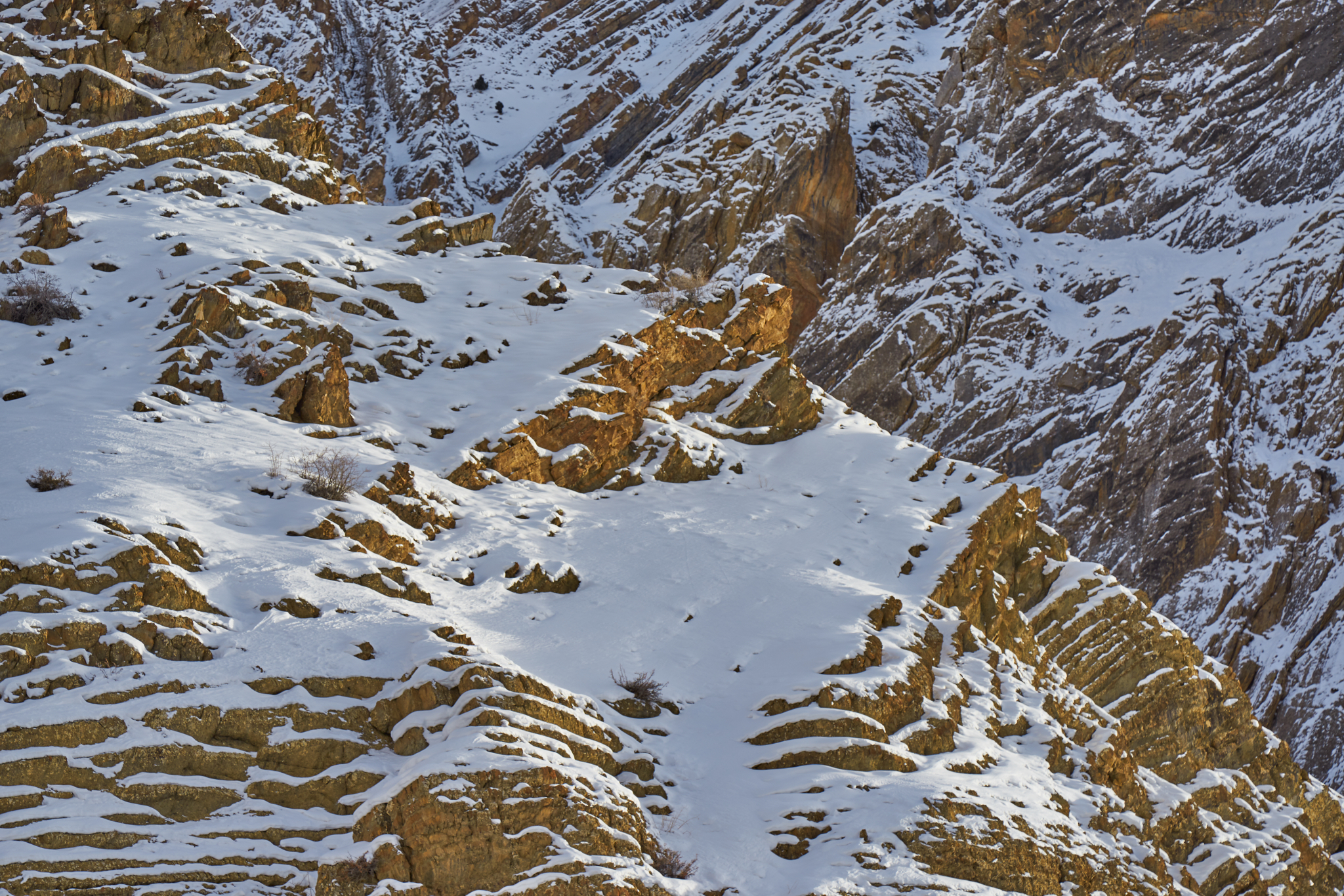
Once I got off the car I started hiking. There were stunning views of snow covered mountains wherever I looked. The only anomaly in the valley that was overlooked by the snow covered mountains were the villages. I felt the windows and doors peeped at me, as if watching my every move.
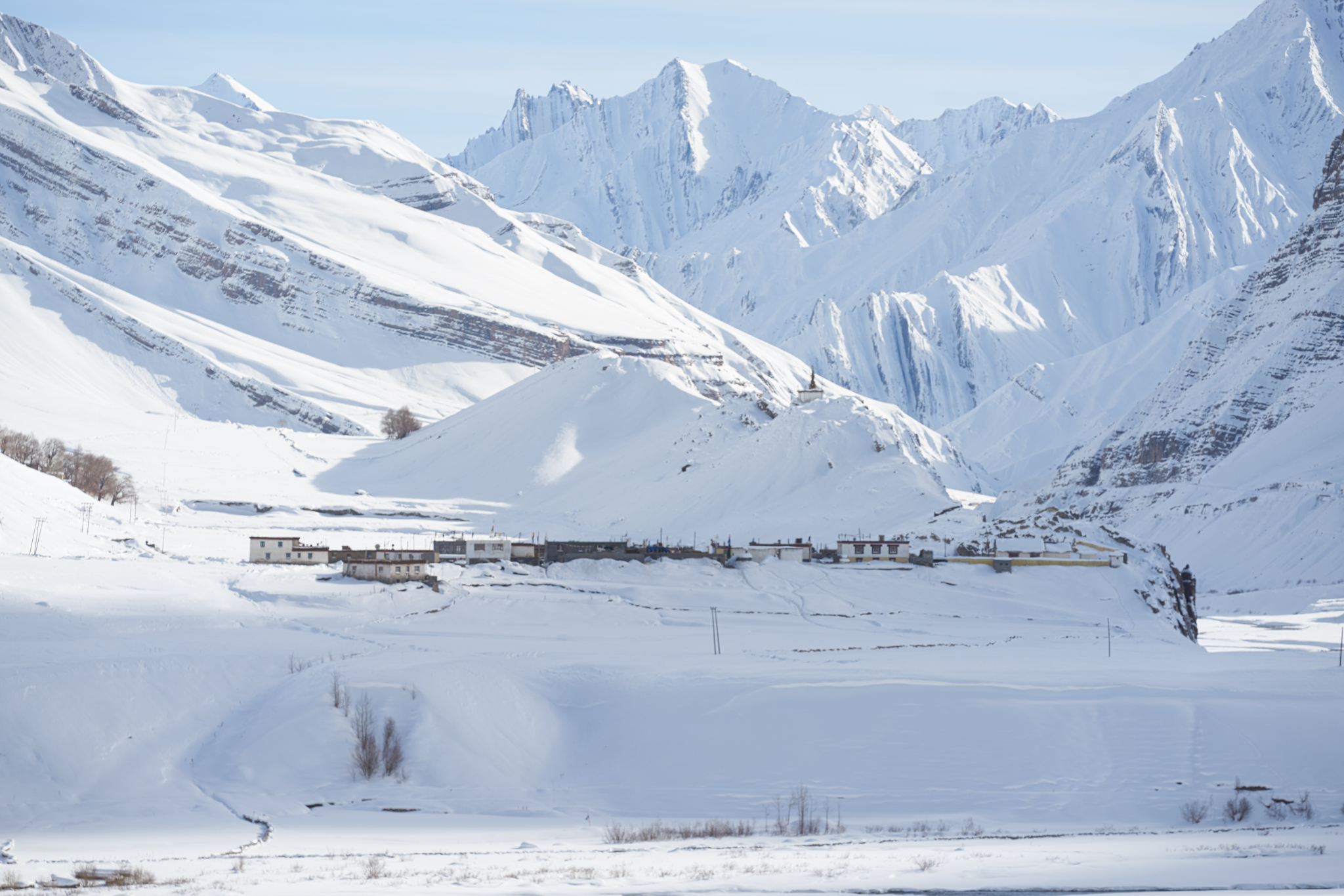
I was stopped at my tracks by an yellow structure at Sagnam village. It looked like a page straight out of National Geographic magazine.
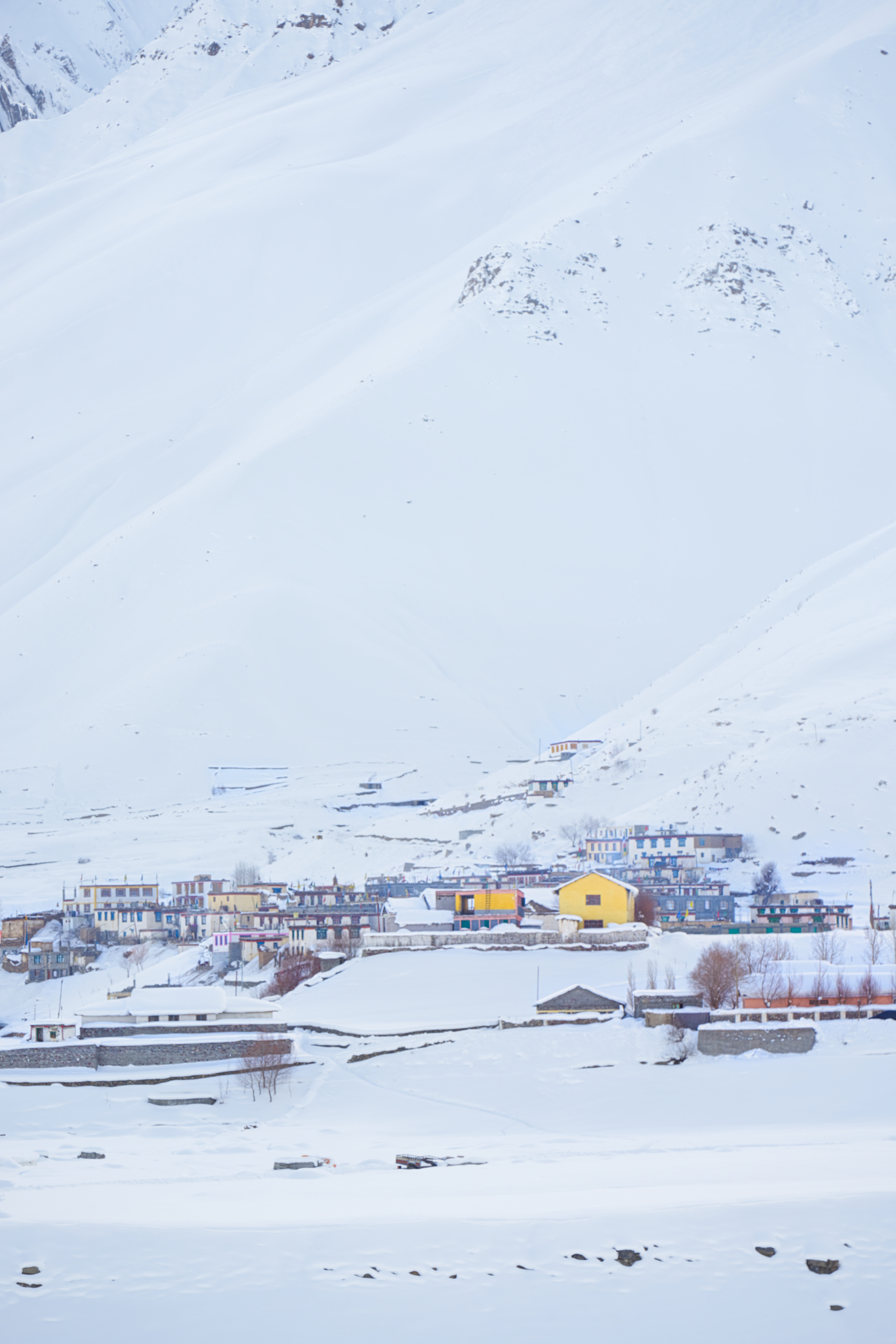
And then there was this village called Tangti Khongma that just seemed to have grown vertically.

To me Pin Valley National Park was the highlight of the trip. I would not mind coming back to Pin valley during different times of the year … to see the colors, to see the villages, to see the stars … and trudging along for a never-ending walk.
After the exhilarating walk at Pin valley, we went to Kaza to stay with Tenzin (our guide for the entire journey) at his home. We were greeted warmly by his wife, Kunga. Tenzin and Kunga’s home in Kaza would be our base for the next two days as we explore the villages of Kibber, Chicham, Hikkim, Komic, and Langza.
Tue, Dec 24 2019
We reached Kibber at around 11 am. We then started hiking to Chicham bridge. It was a couple of miles of walk to the bridge. Chicham—the bridge (on the lower right corner of the photo) is the only connection for the village (on the upper left corner of the photo) to the rest of the world. Children from the village cross the bridge and walk about 3 miles to get to school.
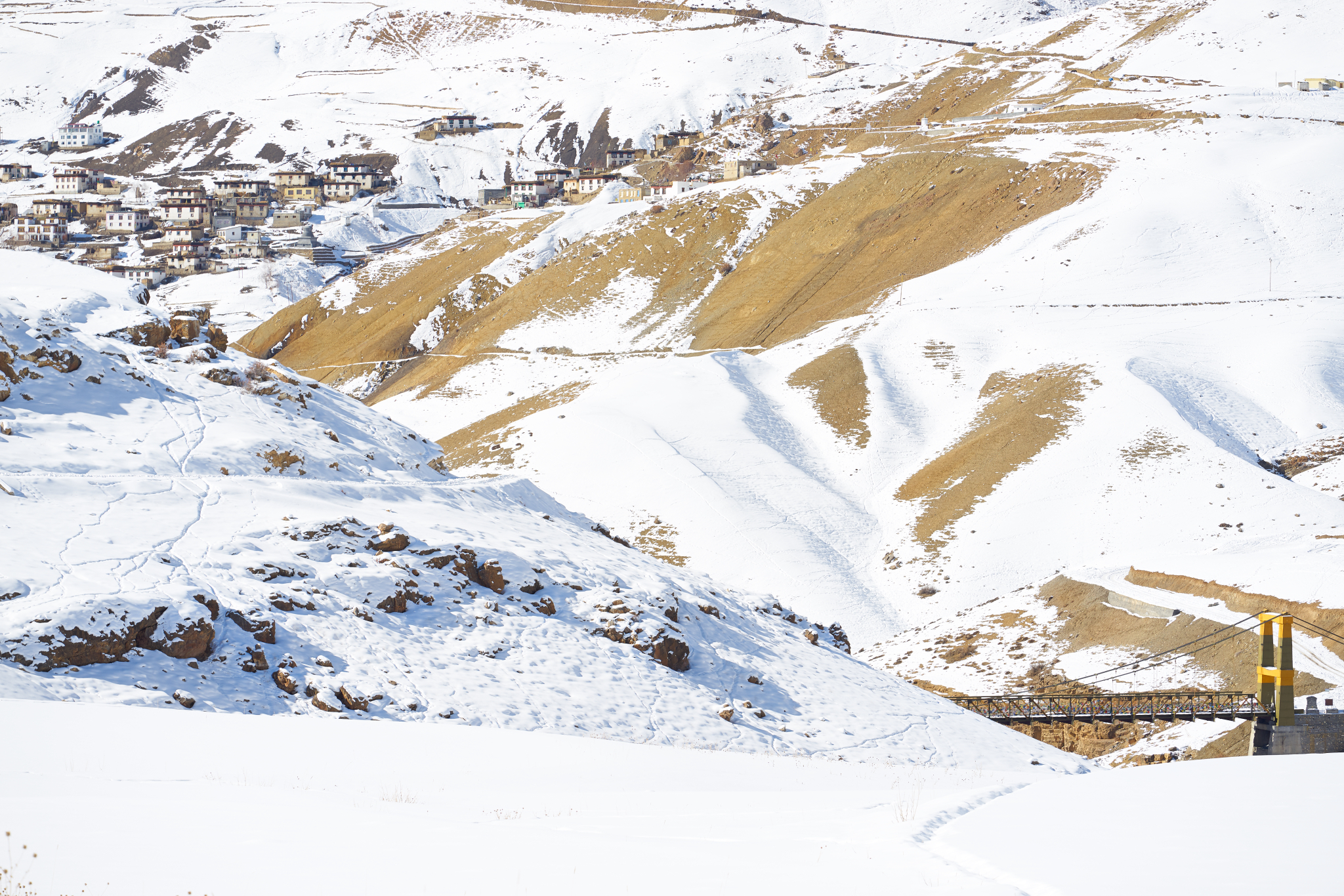
The village looked so pretty from afar that I almost lost track of time. I stood there for several minutes and gawked at this beauty.
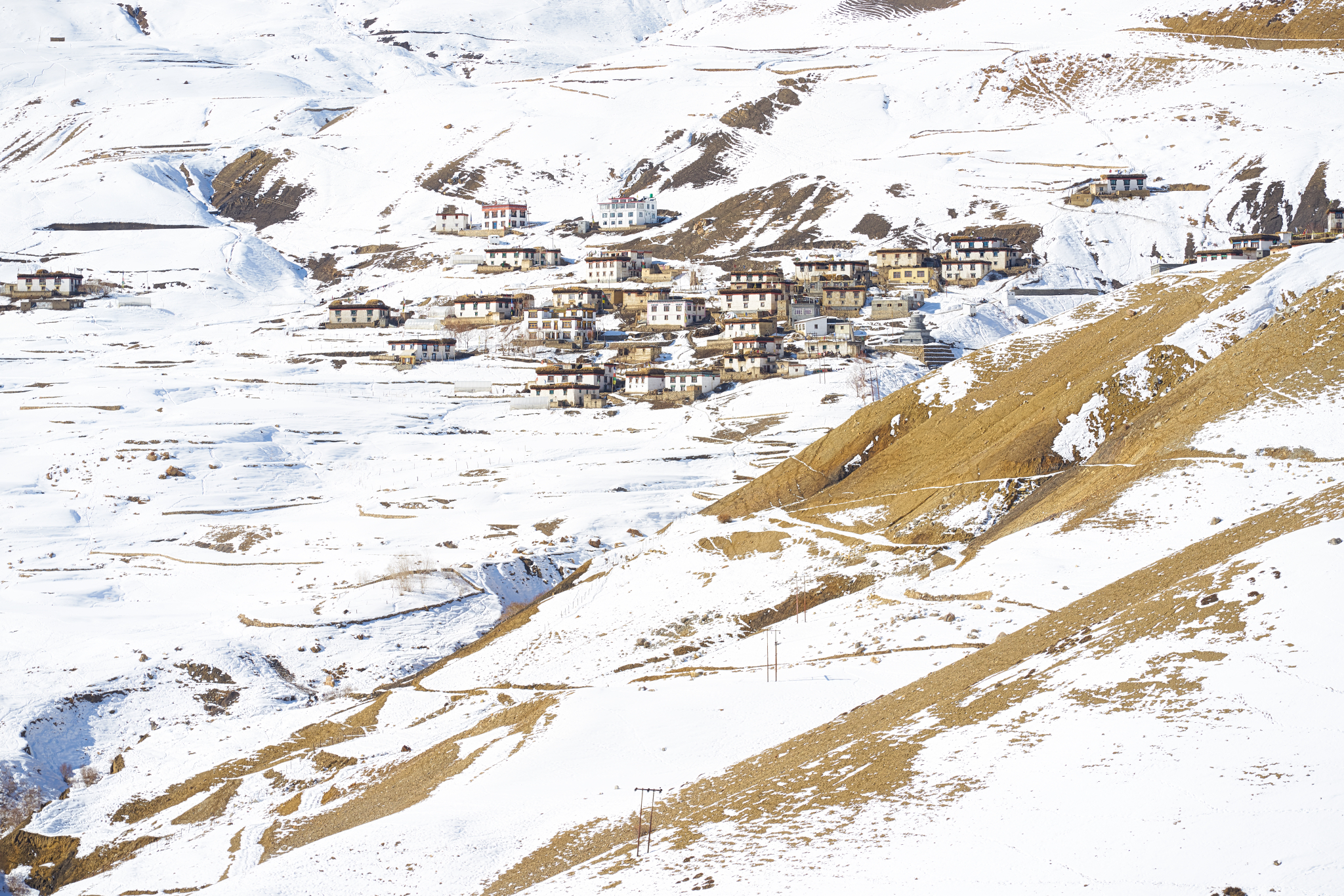
The landscape around Chicham was mesmerizing. It looked like the deep canyons and gorges of Arizona and Utah. The red and white was like the earth’s blood and bones.

After Chicham we went to Key Monastery. Key Monastery, situated at an altitude of 13,668 feet, is the biggest monastery of Spiti Valley and a religious training centre for Lamas. The monastery accommodates about 350 monks. It was initially established in nearby village of Rangrik, which was probably destroyed in the 14th century when the Sakya sect rose to power with Mongol assistance. Key was attacked again by the Mongols during the 17th century, during the reign of Dalai Lama V. In 1830, it was again destroyed during the wars between Ladakh and Kulu. In 1841, it was severely damaged by the Dogra army. Later that same year, it suffered more damage from a regiment of the Indian army. In the 1840s, it was ravaged by fire and, in 1975, a violent earthquake caused further damage.
As claimed by an inscription on the monastery’s wall, repeated attacks and successive trail of destruction have supposedly resulted in a haphazard growth of the monastery. However, in stark contrast, when I went inside the gompa I only experienced peace and harmony. The monk who showed me around the gompa only exuded compassion.
After a tour of the monastery, I went into the prayer hall, sat down, and closed my eyes. I don’t know how long it had been since I closed my eyes and started following my breath. When I opened my eyes I saw these god beams pierce through the window panes. They were always there … it was my awareness that had changed. The truth was right in front of me. Giving ourselves a few moments can dispel our darkness. Giving others a few moments can dispel their darkness.
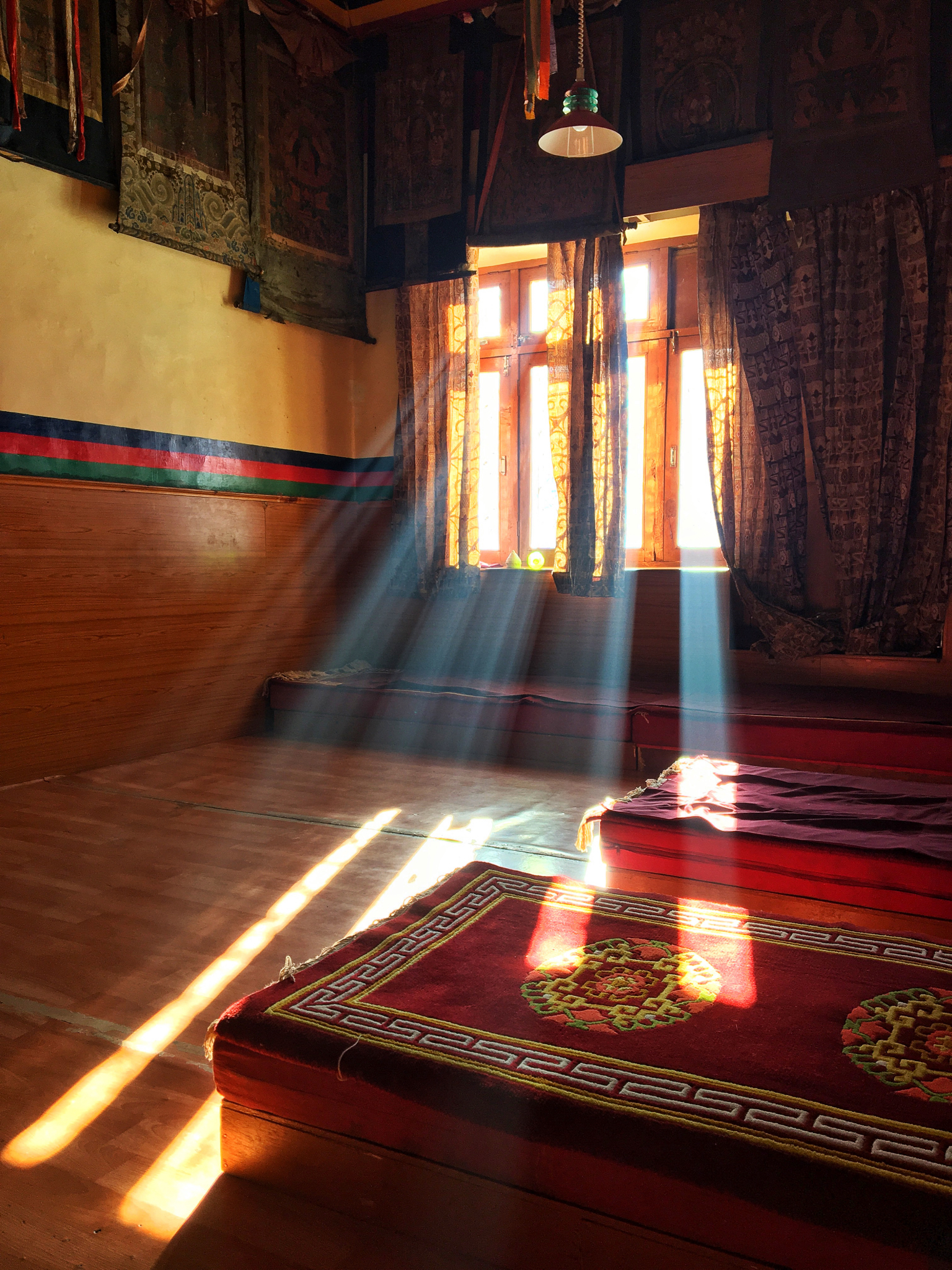
While I was meditating in the prayer hall, Tenzin was preparing our lunch in the monastery’s kitchen. Nobody asked him to do that. It was only his sense of compassion and service that was driving him. All of us, who live in the cities, have so much to learn from the simple, beautiful, and compassionate people of Spiti.
After our lunch, Tenzin, Janarthan (a fellow traveller), and I hiked up the snowy cliff to get a bird’s-eye view of the monastery. The monastery almost looked like a mirror image of the mountain behind it. It never looked like it had suffered any destruction or that it had grown haphazardly. It seemed to be in complete harmony with its surroundings. I’m invariably drawn to places where humans have bonded with nature in extraordinary ways—where human architectural elements have seamlessly blended with nature. Key Monastery looked right up there on top of the list. I shot the monastery from multiple elevations, multiple angles, and with multiple lenses. Not for a single moment did it seem to me that any of the buildings were out of place. Everything was just as it should be … in complete harmony with nature. If there is any shortcoming it is only in the way that I’ve captured it.


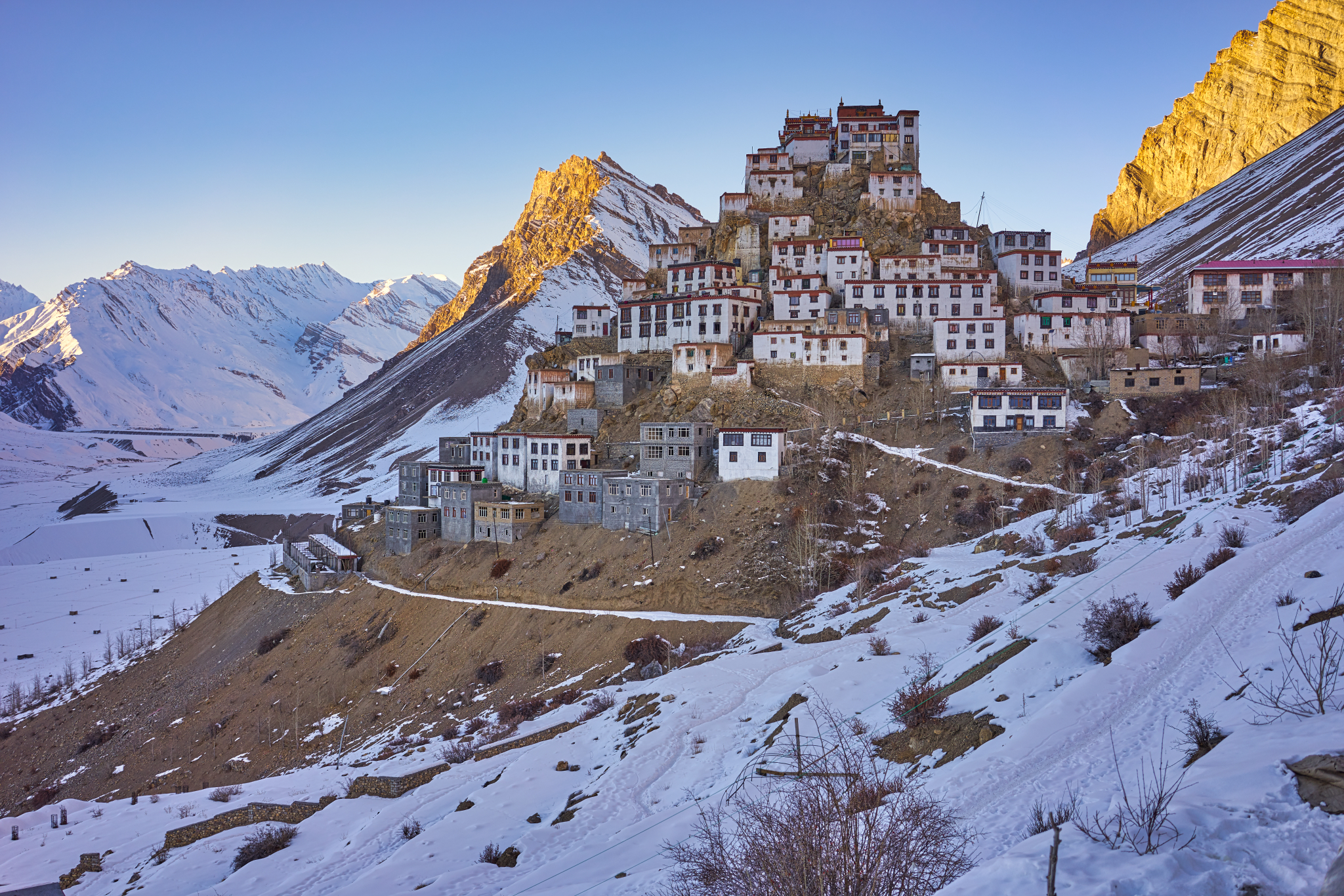
By the time we returned back to Tenzin’s home it was quite dark. We all sat in the living room around the ‘tandoor’ and recollected the amazing memories that we have created so far.
Dec 25, 2019
I woke up around 3 am and decided to go up to the terrace and look up to the sky … just because I can. Surprisingly, though the temperature was around -25ºC or so, I wasn’t feeling too uncomfortable to be out there. Rather, my heart swelled with joy, as I saw our galactic center right before my eyes.
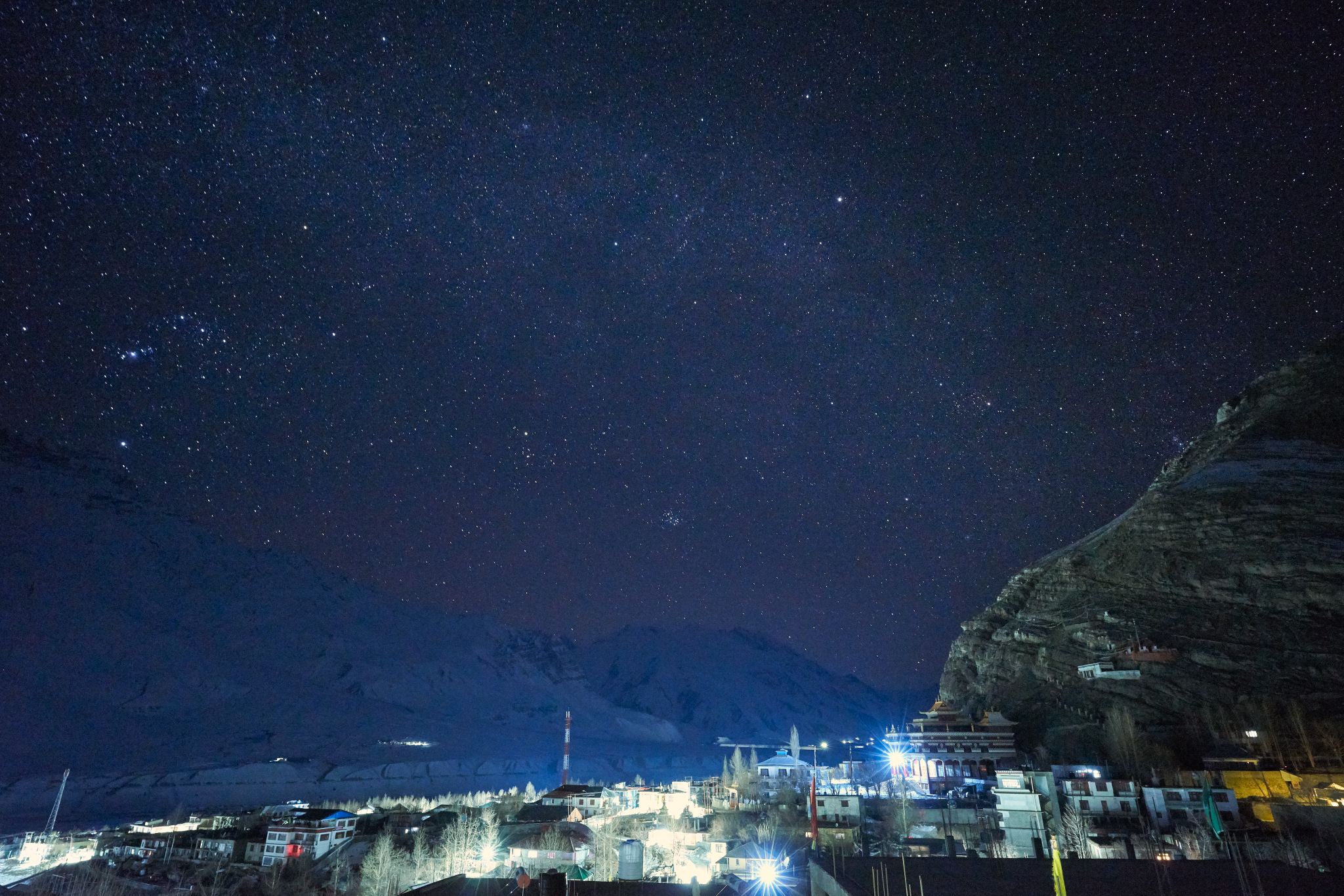
And when I looked up, I saw the Big Dipper shinning like a string of diamonds.
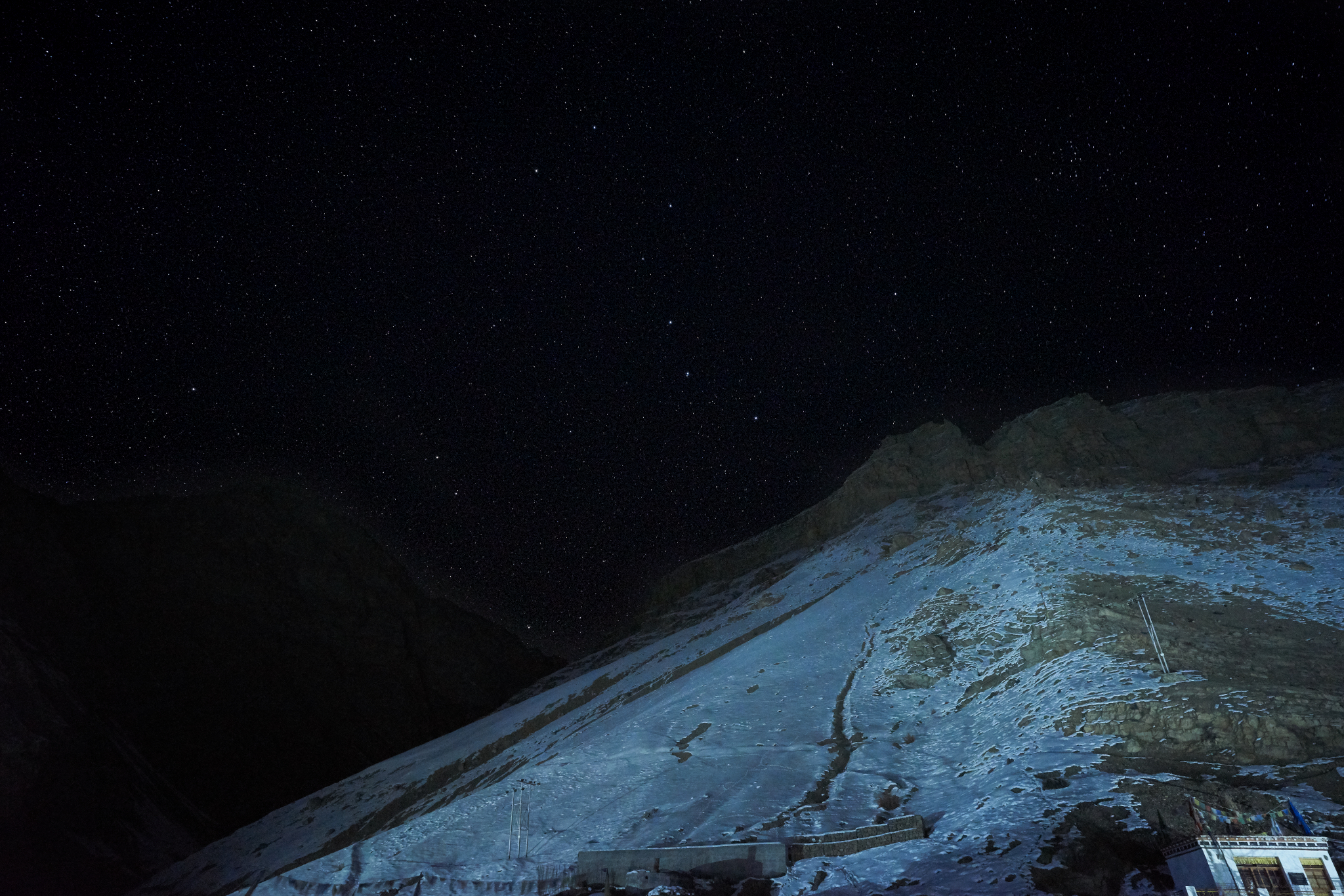
Every time I look up at the sky and see the stars it broadens my horizon, expands my consciousness, and makes me realize that I’m all but a speck of galactic dust floating around in the universe. We are all in the process of transition, of finding our spot in the universe, realizing our higher selves, and above all finding everlasting happiness. These are the goals that binds us together.
Everlasting happiness is what each one of us is striving for. But how do we find it? Is it through the differences of cast, religion, race, nationality, and the ensuing hatred and anger? Or is it through the realization of the limitlessness of the universe, the insignificance of our mortal selves, our universal quest for everlasting happiness, and the ensuing compassion to work toward a common destiny? Once we reflect upon it … the answer is easy.
It was again a bright morning with clear blue skies. Dev was negotiating the hairpin bends like a walk in the park. He is one of the best drivers that I’ve seen in my life—calm, confident, and effortless in his driving. He could easily be my mentor for driving around the Himalayas.
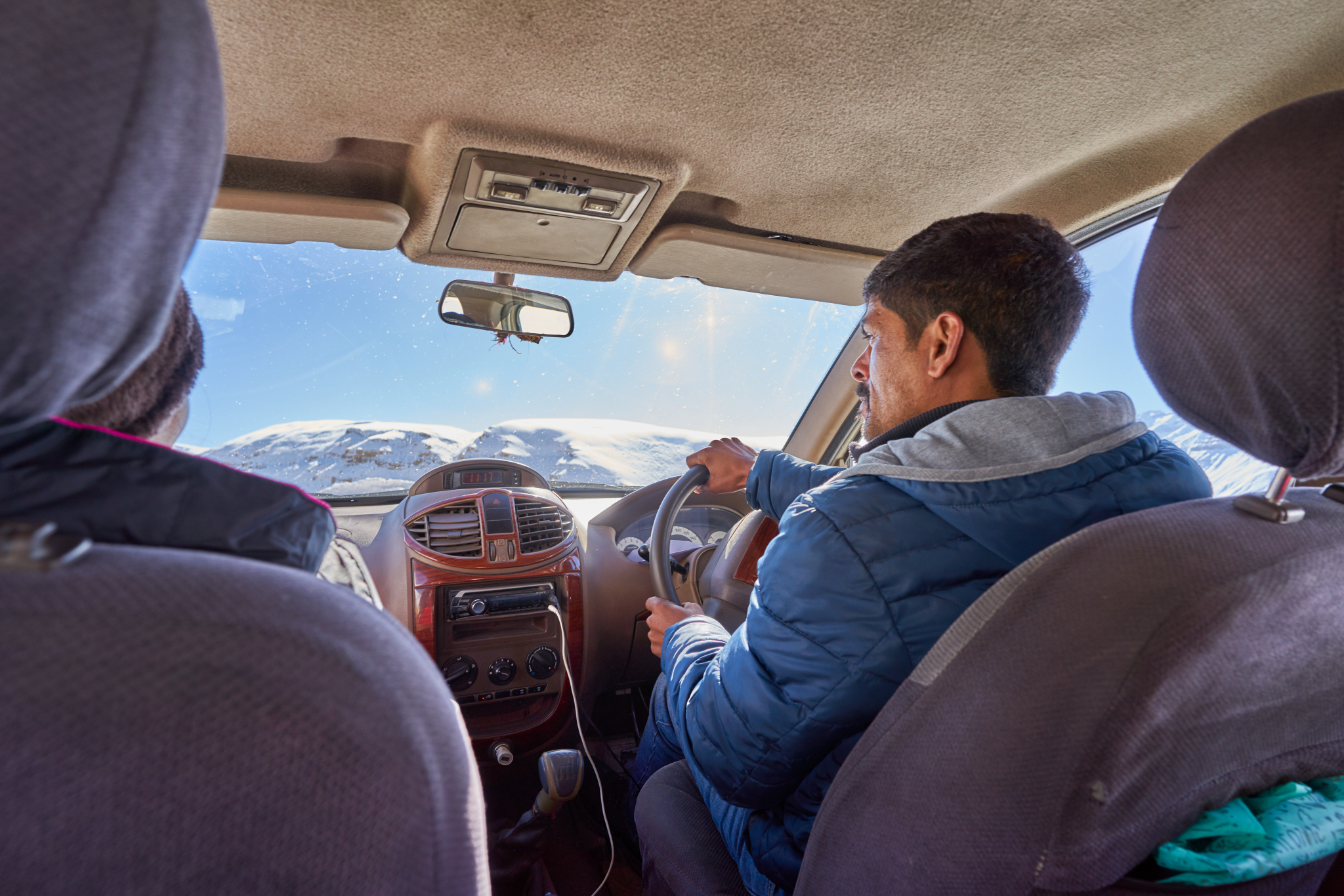
I admired his driving as much as I admired the view outside. While Dev was drifting through the icy roads my mind was drifting through its own lucidity. There was no anxiety, no anger, and no fear. It was spotless like the clear blue skies. And then I realized, that the true nature of the mind is to be luminous and its default state is that of compassion—just like the clear blue skies! And just when I had those thoughts, the prayer flags appeared in my field of vision … neatly organized in sets of five—yellow, green, red, white, and blue—representing the five elements that are the building blocks of all material existence—earth, water, fire, air, and space respectively. The locals call the flags Lungta, meaning the wind horse, that carry the prayers through the wind. I wished that we stopped here for a while and took the time to realize the beauty and depth of the symbolism … and maybe … just maybe … say a prayer or two.
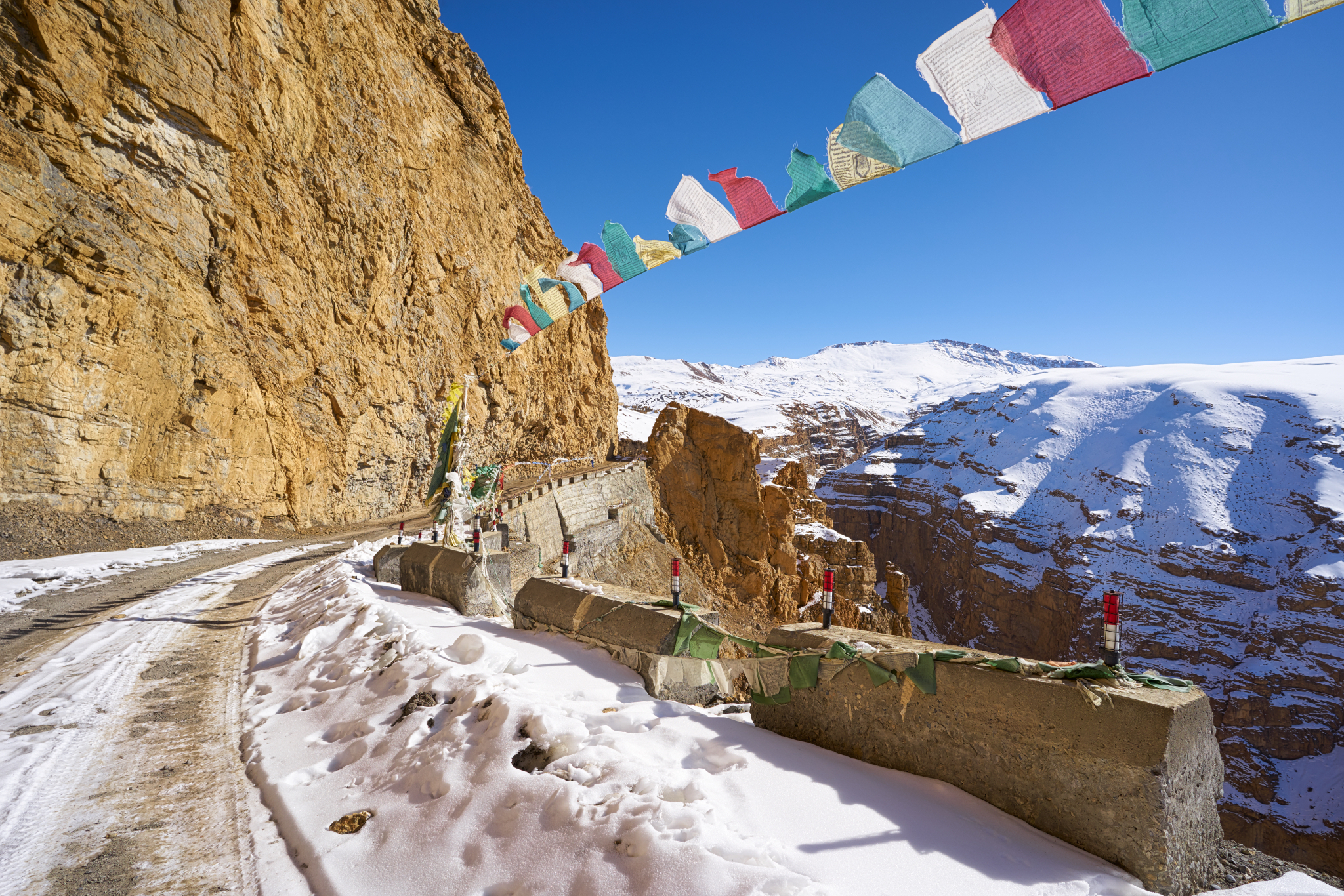
I don’t know if Dev sensed my eagerness to stop or he generally stops here so that the travelers can take photos. But he did stop … right where the flags seemed to have converged. As I stepped out of the car, I noticed that the sun rays filtered by the flags had created a kaleidoscopic effect on the snow beneath my feet. The snow was the canvas on which nature was painting the five elements that we are all made of. The oneness of our existence was right before our eyes. At that very moment, there was only one prayer on my lips … that the world finds this oneness and lives with compassion. Lungta, will you carry this message of mine?
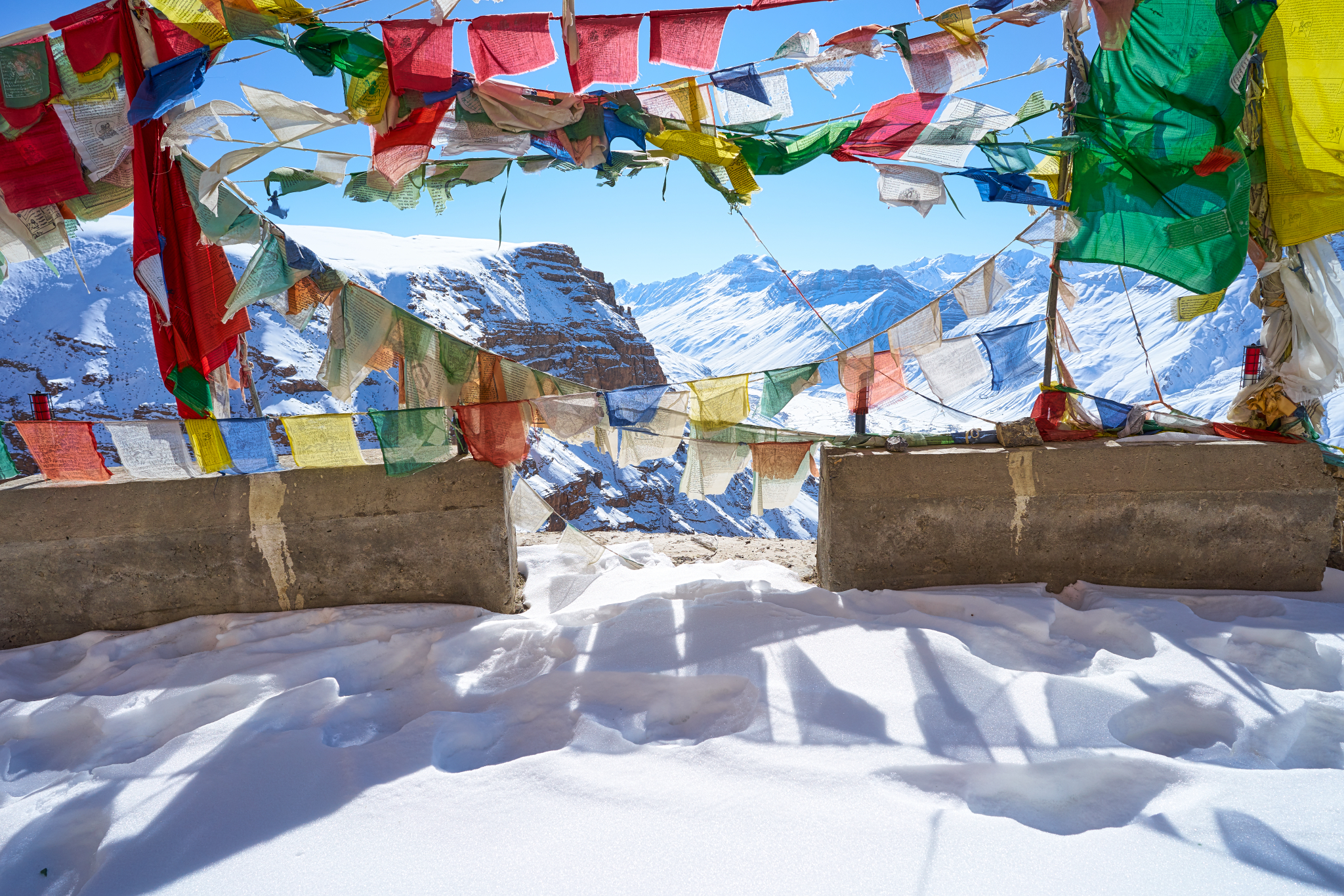
In less than half an hour we reached Hikkim—one of the highest year-round inhabited locations in India. The houses in this village are primarily built of stones, wood, and mud. Not surprisingly, there was no sign of human life. After a while, an old lady came along carrying a basket on her shoulders and a smile on her lips. I looked at her and smiled. She beamed and said “Juley!” I’ve come to know by now that Juley is a magic word. If you want to say “hello” say “Juley” … if you want to say “goodbye” say “Juley” … if you want to say “thank you” say “Juley” … if you want to say “how are you?” or “nice to meet you” or “you’re welcome,” just say “Juley.” In other words, if you’re in Spiti and don’t know what to say, just say “Juley” and see the magic happen. You’ll see compassion and joy in the eyes of every Spitian that you greet. You’ll realize what compassion looks like. Don’t take my word for it … just say “Juley” when you meet a Spitian and experience it for yourself.
That “Juley” brought a spring in my step. Guided by Tenzin, we hiked down to what is supposed to be the highest post office in the world. On the way, we crossed a few houses and I could hear voices of children playing inside. I remembered, I had bought some chocolates to giveaway to the kids of Spiti. Up until now, they had remained in the car as I was yet to meet a kid. Since winters are harsh, the elderly and the kids generally move to warmer places. So, I was delighted to hear the soft, playful voices emanating from behind closed doors. I made a mental note to get the chocolates from the car after our visit to the post office.
As we got to the post office, the first thing I noticed was the brightly painted closed blue door. I was surprised to see a closed door since we were well within the working hours of the post office. However, I soon remembered, the story of two postmen of Hikkim post office that I had read about while doing my research on Spiti. In the story, the two postmen would make an arduous 30 mile round-trip journey on foot each day across high mountain passes to deliver mail to Kaza, that is connected by road to other larger towns in the state of Himachal Pradesh. From Kaza, the outbound mail is dispatched via buses along often treacherous mountain roads, while inbound letters are carried back on foot to Hikkim. I totally understood if they decided to leave early today and come back before sun down.
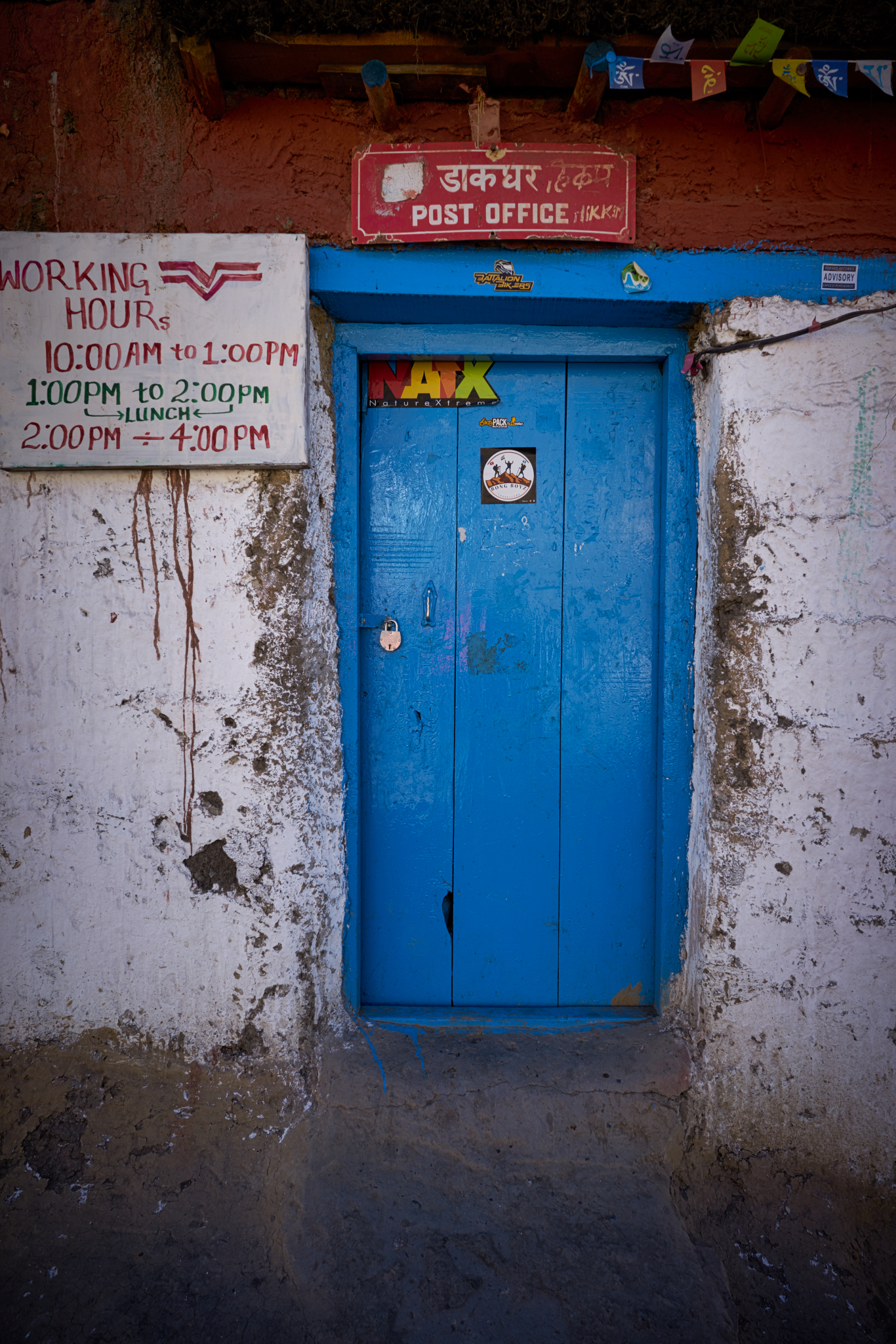
Though the post office was closed and the postmaster Rinchen Chhering—who has been running the operations since its inception in 1983—was most likely out delivering and collecting mail, all was not lost. Tenzin gave us hope by saying we could handover our letters to the postmaster’s wife and she’ll make sure that they are delivered the very next day. So, I wrote couple of letters—one to my wife and the other to my boy—and both have eventually made their way to our home. My son was surprised to receive his first postcard and my wife gave a certain doe-eyed look that brought back some memories from the day I got married. 🙂
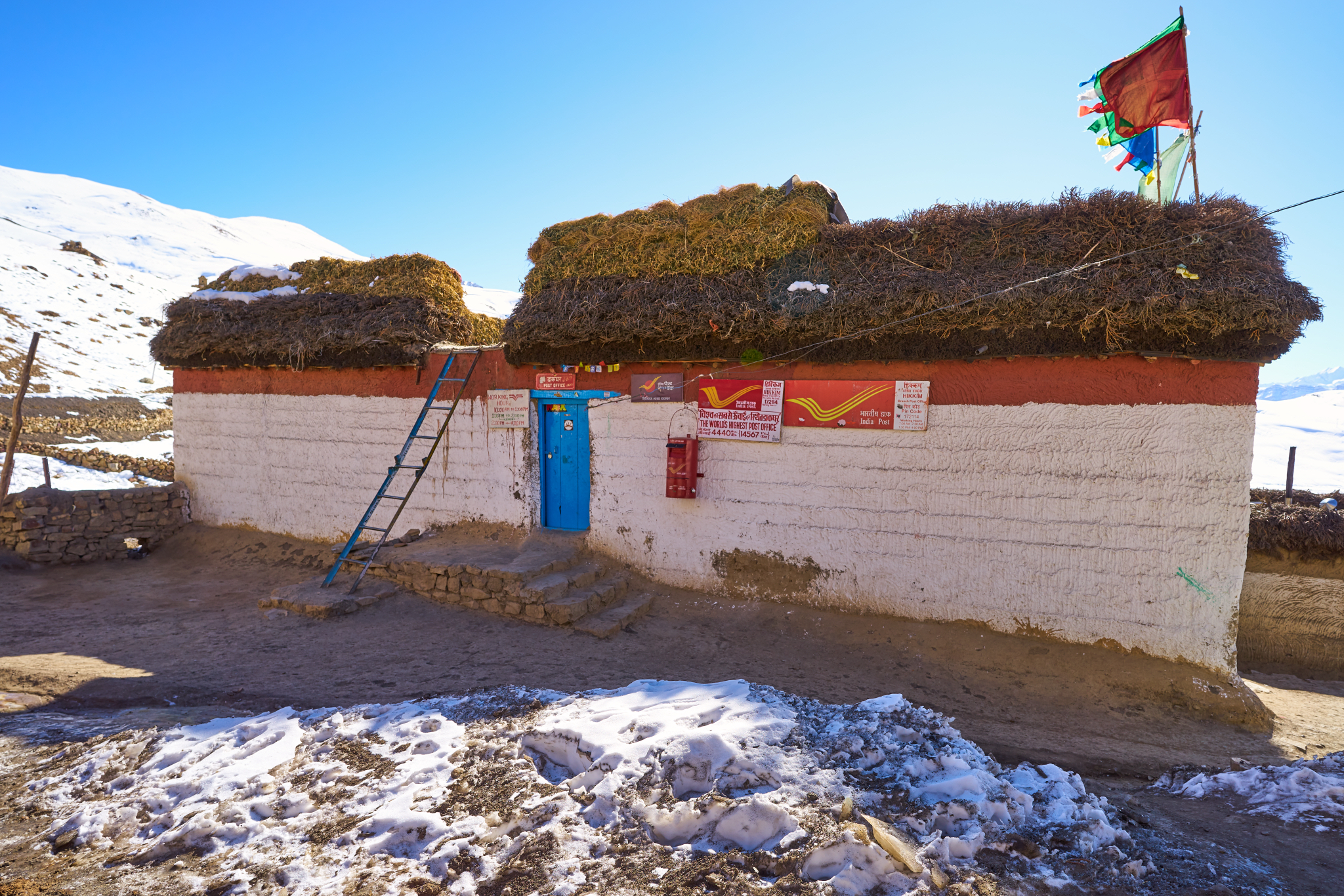
On the way back from the post office I did knock on the door of the house where from I had heard the voices of children. A cute child, with bright beautiful eyes, opened the door. For a split second it seemed like I had traveled back in time, by a decade, and was looking at my son’s face. In my mind, the boy was a splitting image of my son when he was about six. I offered the boy a chocolate and he took it with a beaming smile. That smile is the biggest thank you that I could imagine. Kids are like that … their actions are reflections of truth … till the time we teach them how to pretend.
Our next destination was Komic—at about 15,049 feet, it is the highest village in the world connected with motorable road. When we reached Komic, the first thing I saw was this side wall of the monastery. Painted red and white … just like blood and bones! The blue sky above and the white snow below seemed to create a lyrical symphony along with the wall.
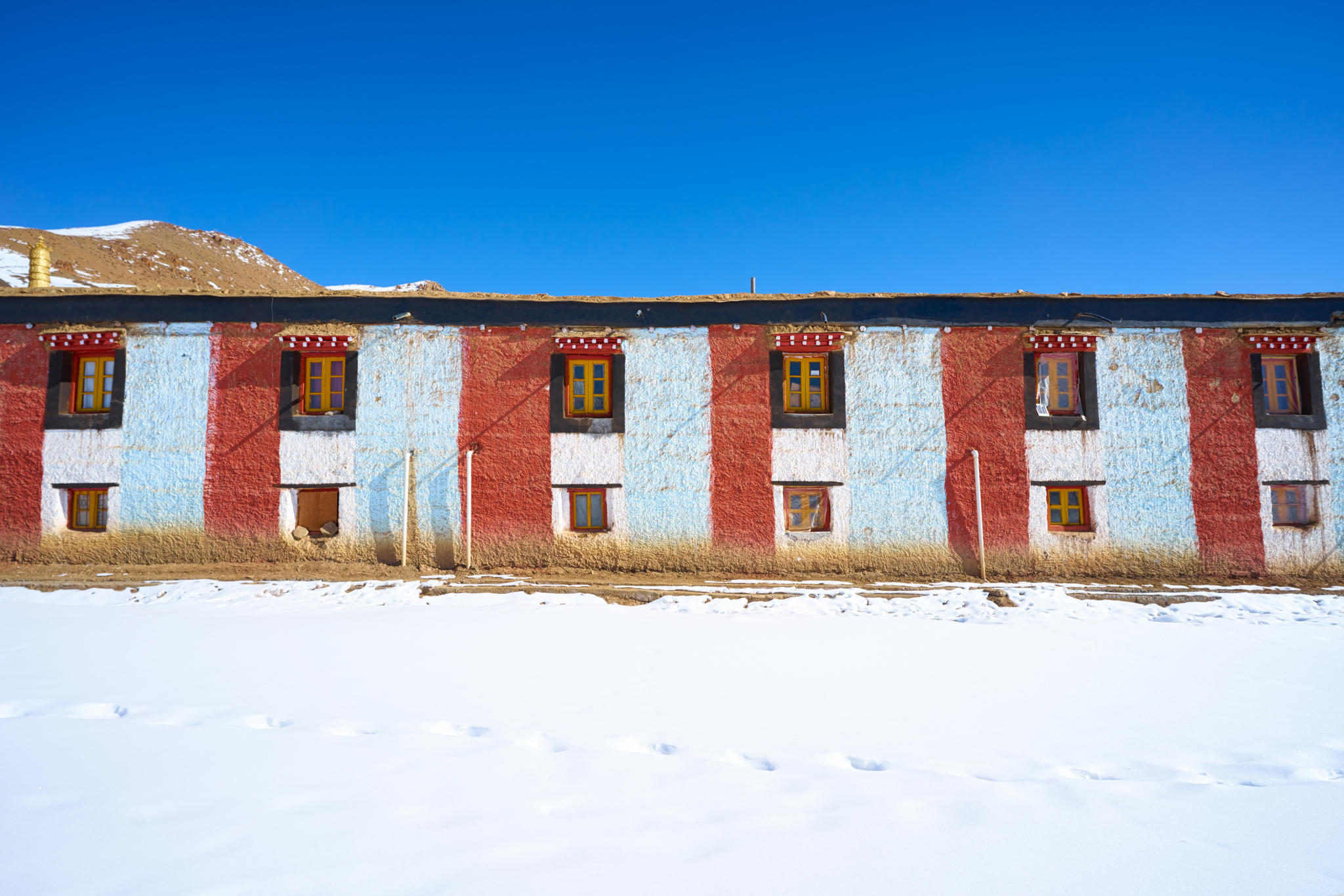
As I turned around the bend, I noticed a partially opened yellow door that was supposedly the entrance to the gompa. It looked inviting but not surprisingly I found out this monastery too was closed. Monks were nowhere to be seen and it looked desolate and deserted.
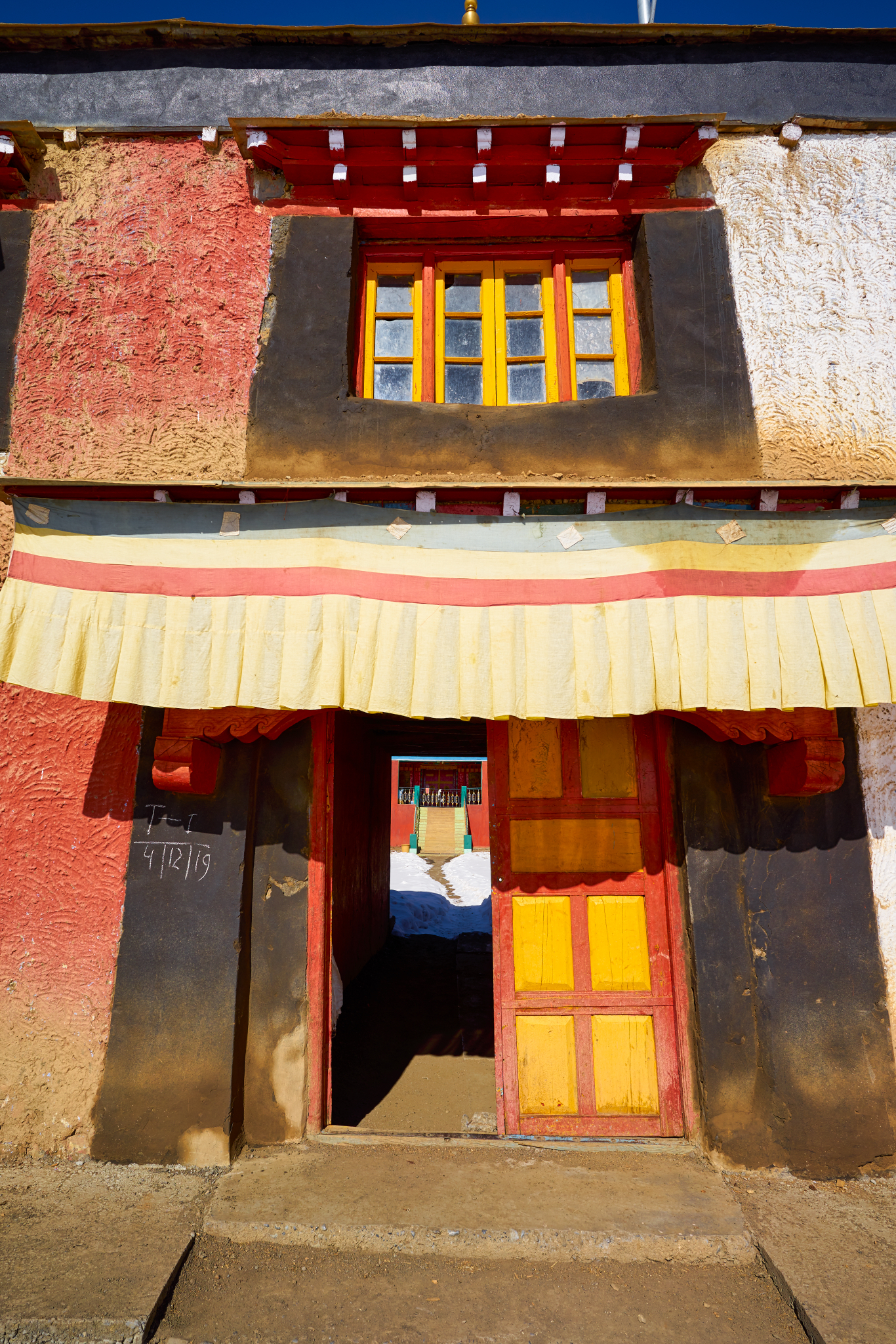
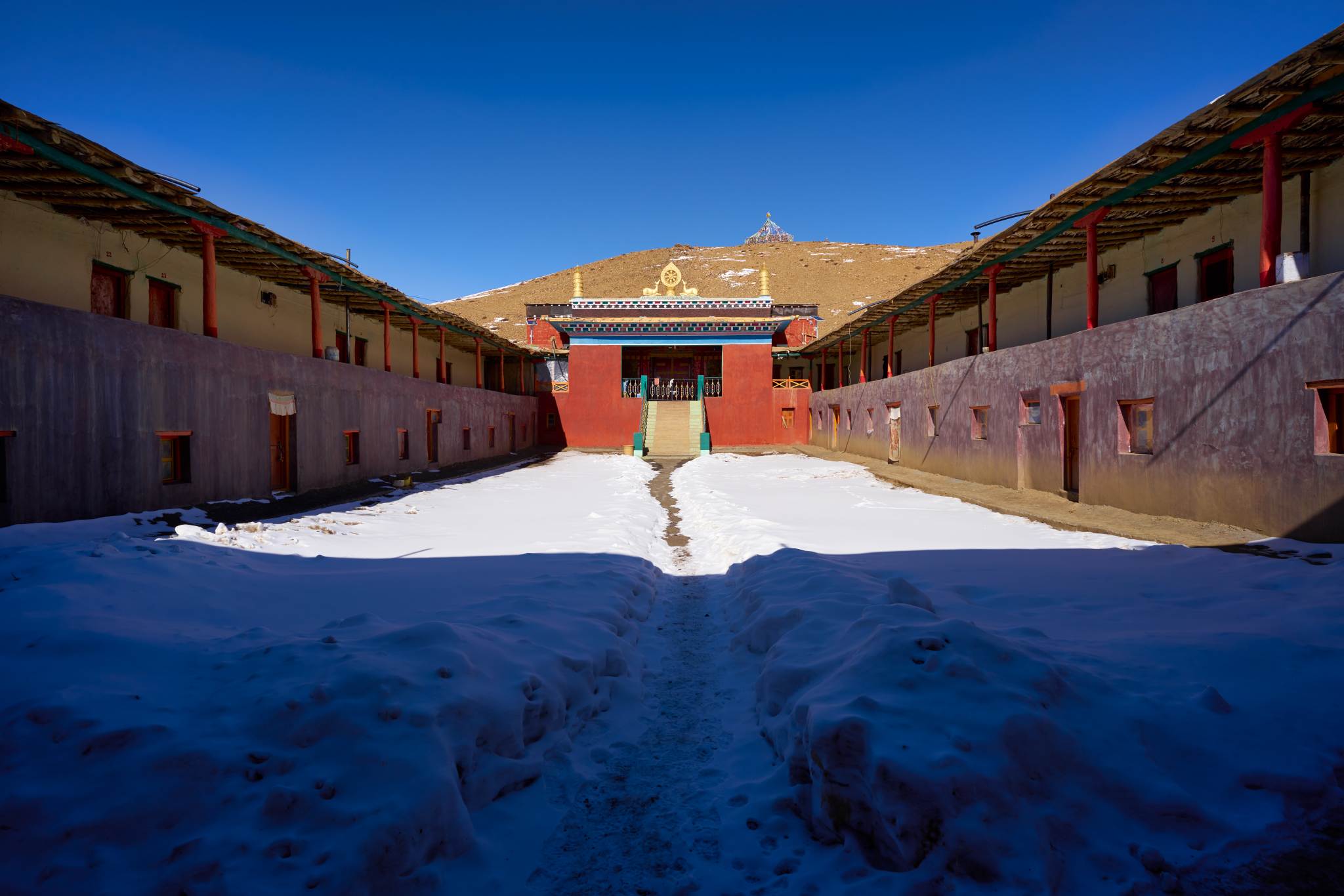
Though we couldn’t see the interiors of the monastery, the view of the valley was gorgeous. While I was taking photos, Dev and Veerappan (another fellow traveler) decided to get some exercise by chopping logs with an axe. We all cheered them in their effort and speculated how the owner of the axe would be pleasantly surprised to see that someone did his job for him.
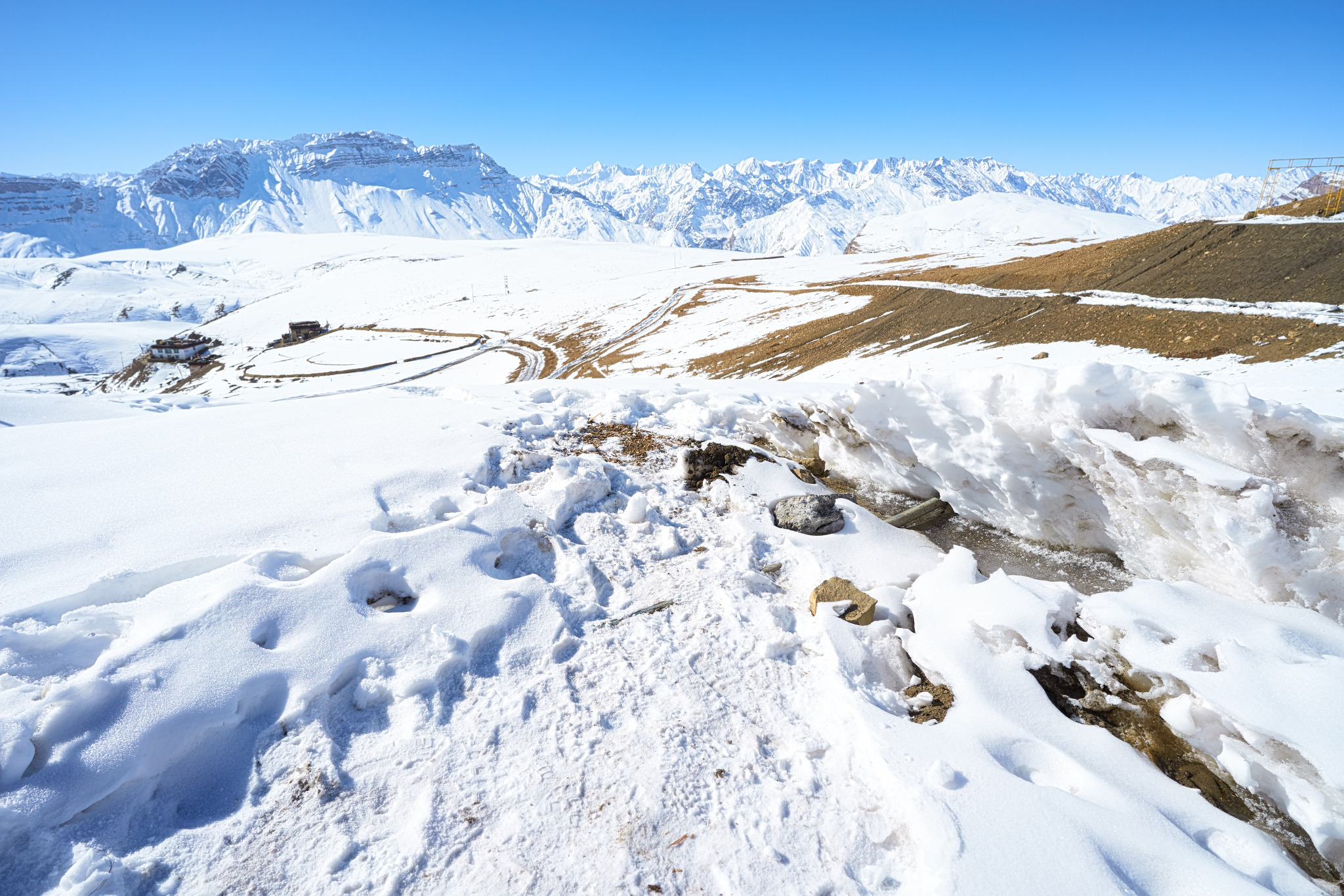
Our last destination for the day was Langza. Folklore has it that when the village faced an epidemic this Buddha statue was built. When the work was completed the villagers recovered and since then there has been no major epidemic. I knew faith could move mountains … now I heard it. I now sincerely hope that the light of Buddha continues to shine upon us and transforms us into more compassionate beings.
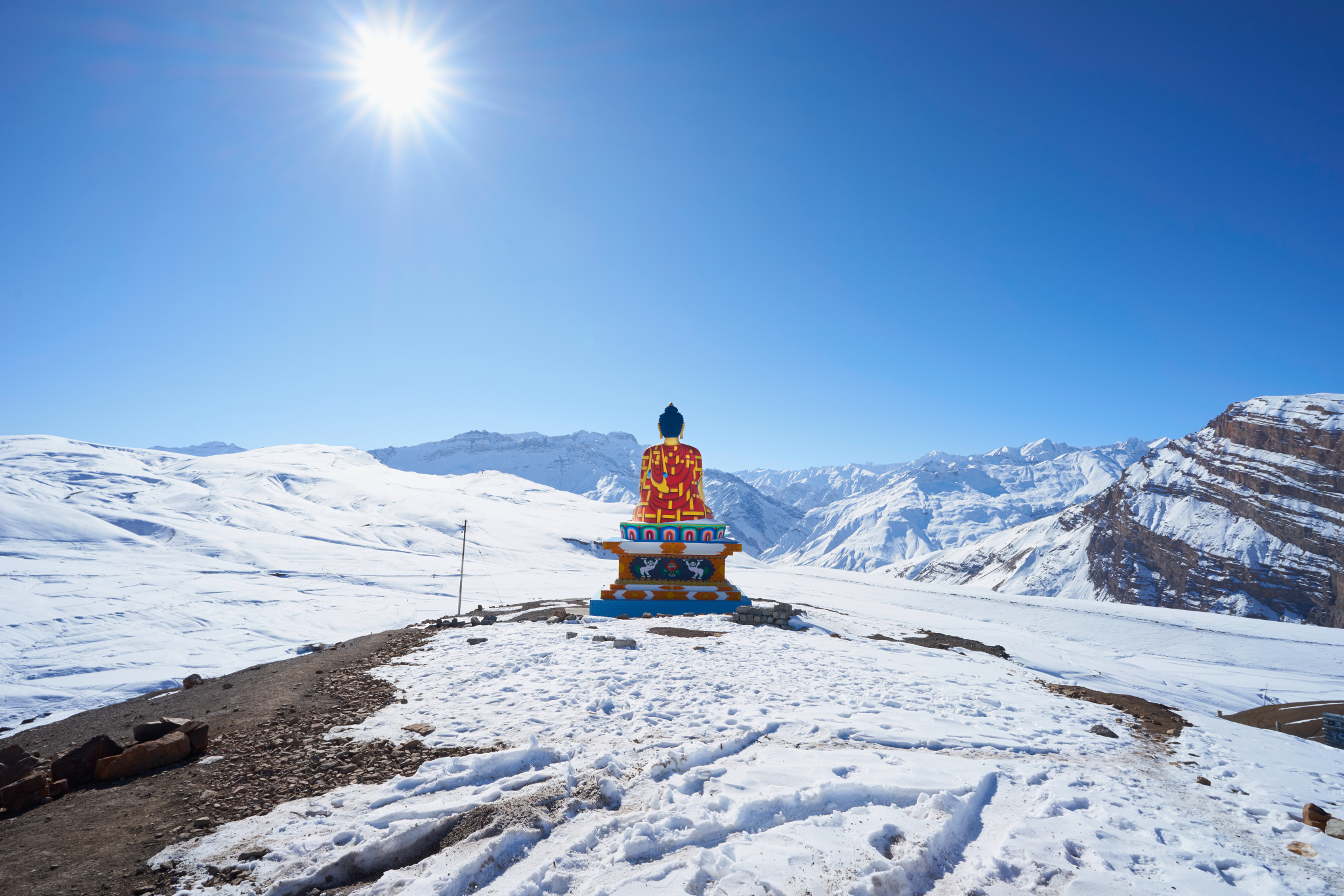
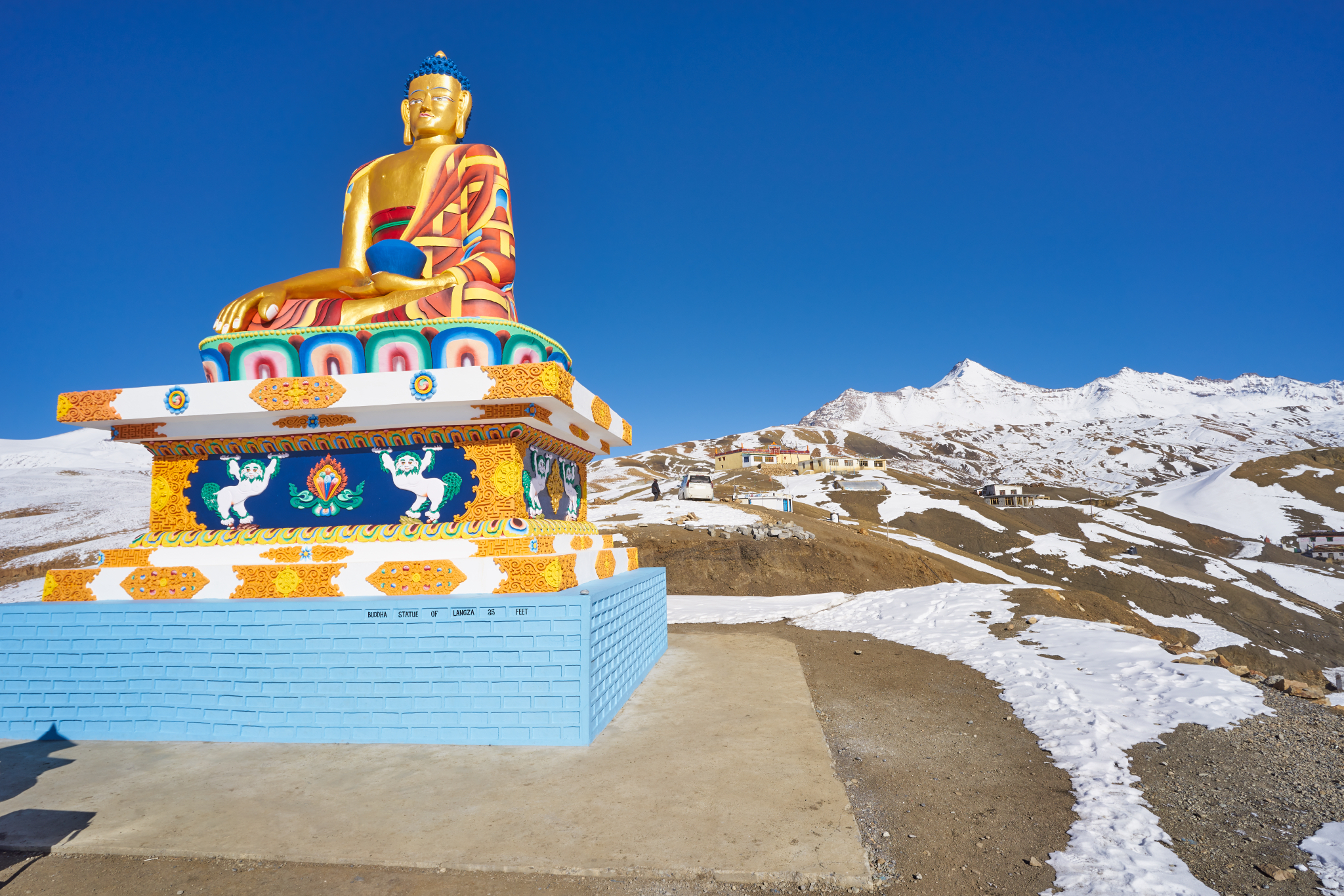
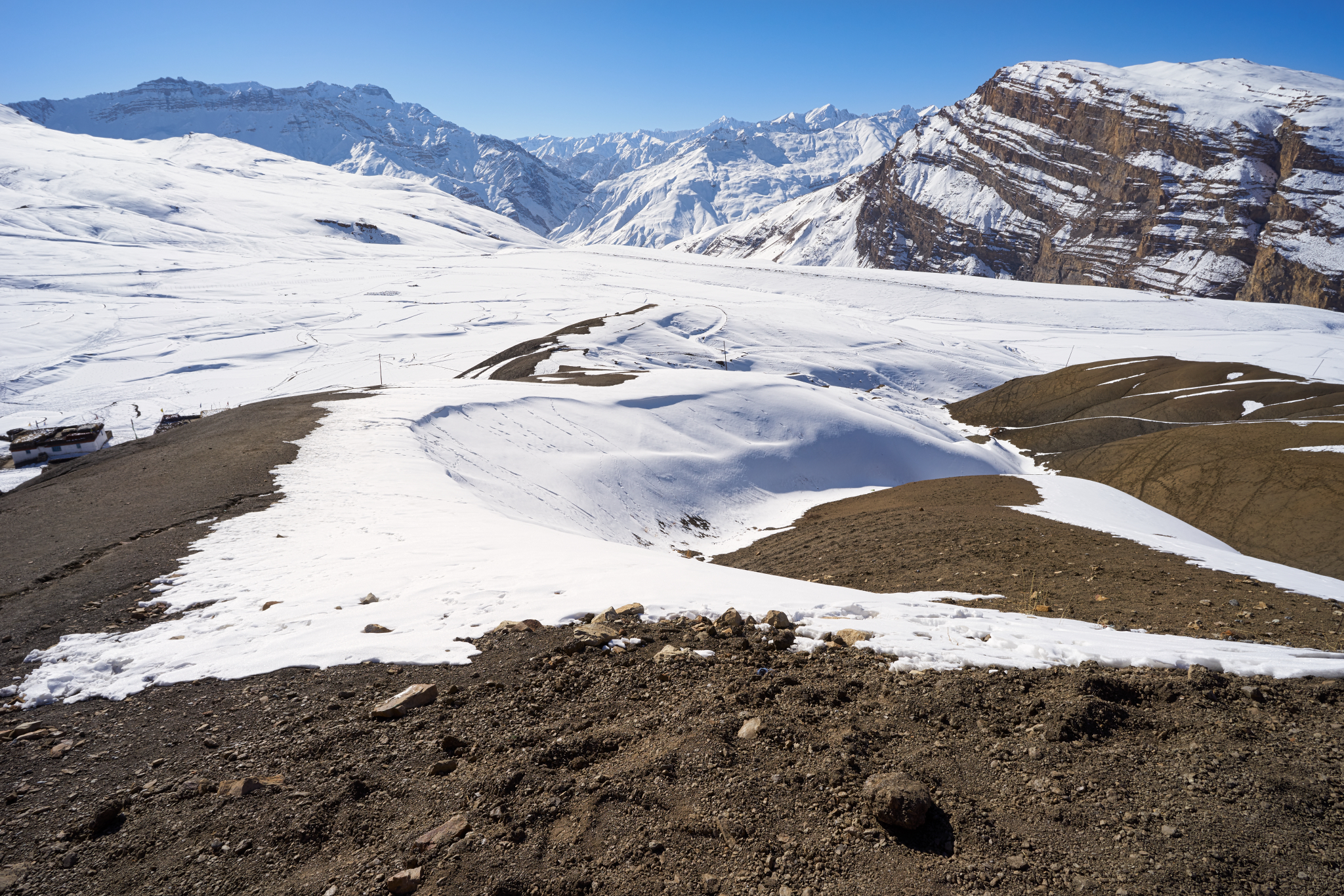
Dec 26, 2019
Today was quite a relaxing day. We spent most of our time in Kaza walking around and visiting the local sites. For a change, I decided not to carry my camera gear. I just wanted to enjoy the beauty with my own eyes and store the frames in my physiological memory. We walked up to the highest altitude petrol pump in India; then to the highest altitude ice-skating rink (members from national ice hockey women’s team were training local kids on ice-skating and ice hockey); then climbed up to the highest point in Kaza to get a panoramic view of the town; then walked around the Sakya Tangyud Monastery (the door here too was closed); and then went for a long hike along the Spiti river. I felt carefree, I felt happy.
In the evening we sat around in the kitchen and chatted as Tenzin and Kunga made Momos for dinner. During the trip, I came to know that Tenzin and Kunga had gotten married recently and congratulated them on their marriage. Kunga was very sweet and friendly and showed me her wedding album. As I looked through the album I got a glimpse of the local culture. It was a fun and joyous evening.
That night after dinner, all of us circled around the ‘tandoor’ and opened our hearts for each other. We shared our stories of travel, experiences from our lives, our aspirations for the future. We laughed, we inspired, and got inspired. It was beautiful.
Dec 27, 2019
The time to rewind came … to get back to our lives where we came from. We left Kaza when the dawn was still dark. The entire day was spent in the car as we made our way to Rampur.
We reached Rampur in the evening and I took a warm bath. Taking a bath after 5 days was the highlight of the day.
Dec 28, 2019
We left Rampur at the crack of dawn and made our way to Shimla. It’s in Shimla that I decided to take a last shot of the mountains before I head back home. I don’t know what I loved most in this trip! Was it the mountains, was it the monasteries, or was it the beautiful people of Spiti? I guess I’ll never know.
